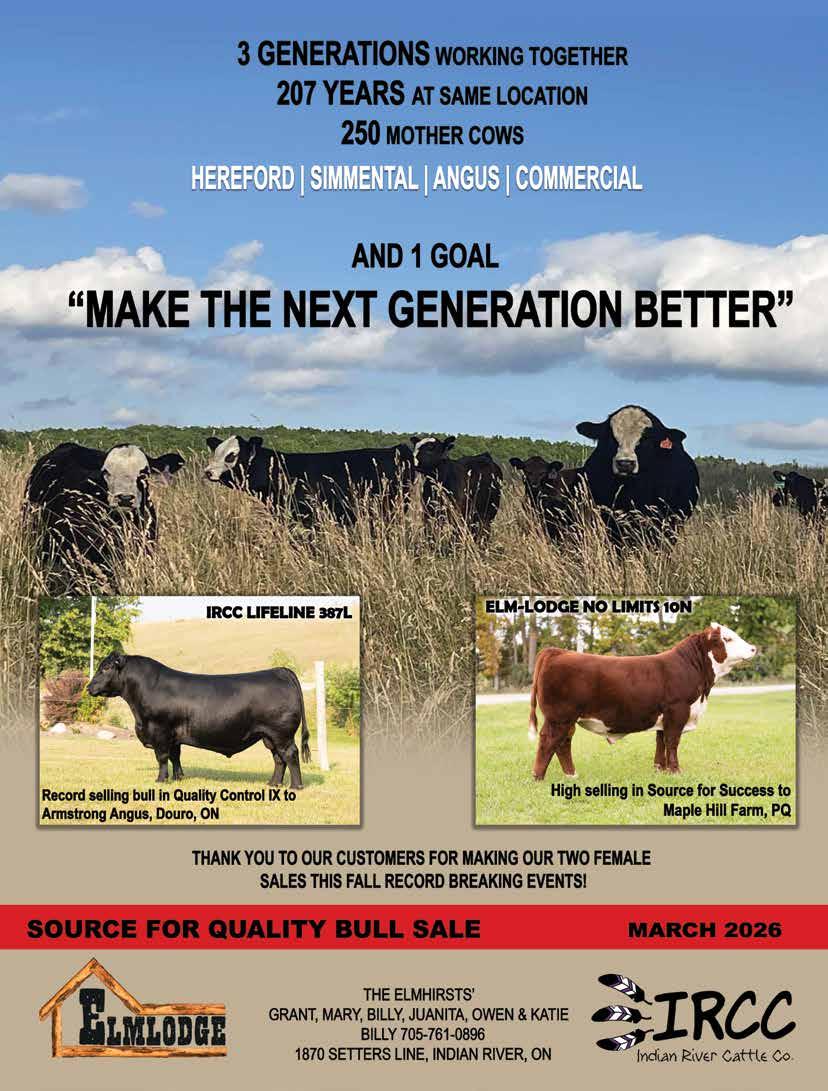CHECK-OFF INCREASE TO TAKE EFFECT IN NOVEMBER • CELEBRATING 10 YEARS OF ONTARIO BEEF IN JAPAN • ROOTED IN STEWARDSHIP: HOW THE VAN OSCH FAMILY SUSTAINS SOIL, CATTLE AND COMMUNITY • OCTOBER 2025
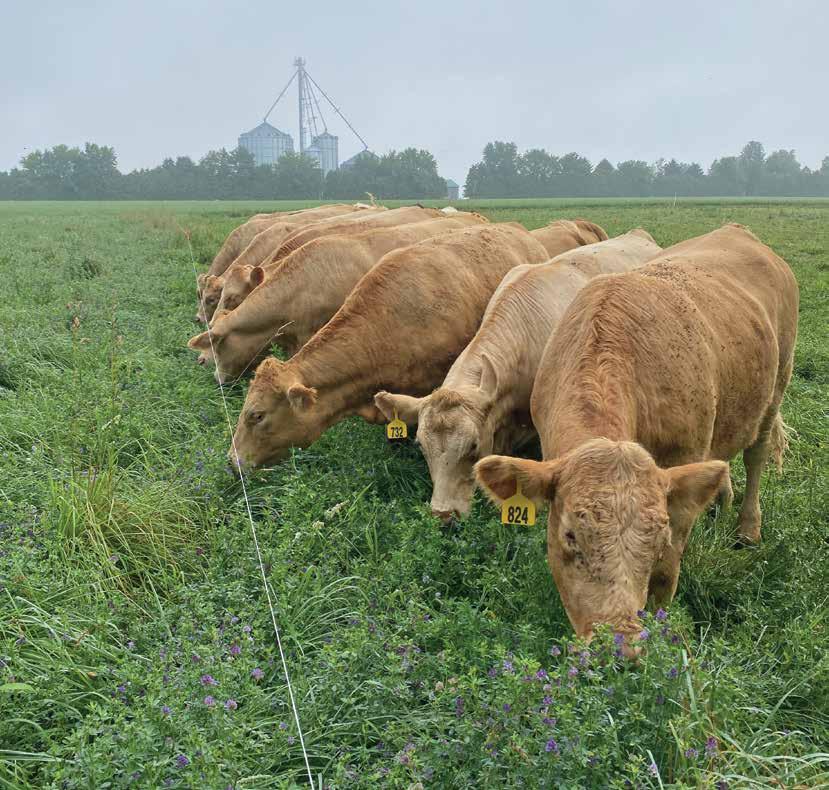

CHECK-OFF INCREASE TO TAKE EFFECT IN NOVEMBER • CELEBRATING 10 YEARS OF ONTARIO BEEF IN JAPAN • ROOTED IN STEWARDSHIP: HOW THE VAN OSCH FAMILY SUSTAINS SOIL, CATTLE AND COMMUNITY • OCTOBER 2025


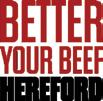
HIDDEN-VIEW POLLED HEREFORDS
Joe and Karen Paszternak NORWOOD, ON 705-9573739 or 705-957-7470 karen.paszternak@gmail.com Bulls & Females for sale
JDL CATTLE CO. & D&S LIVESTOCK
David & Shirley Lasby
Josh Lasby, Justin & Jaimie Lasby & Family, Jessica Lasby & Travis Fulford & Family MULMUR, ON 519-943-4147 or 519-278-6819
jessica.lasby@hotmail.com
Good-looking, Sound, Functional Cattle!
LIAN MOR POLLED HEREFORD
Wally & Fern Pugh MONO, ON
Wally & Fern Pugh lianmor48@gmail.com · 519-941-8515
Trevor & Amy tpugh27@yahoo.com · 519-939-7489
Breeding Stock Available
MEDONTE HIGHLANDS POLLED HEREFORDS
3055 Universal Dr. Mississauga, Ontario (905) 625-3151
maria@standardmechanical.com
“6 Star Breeder”
O’SHEA FARMS
Jamie and Mel O’Shea DENFIELD, ON 519-477-1238
osheafarms@hotmail.com Bulls and Females for sale
WHISKEY LANE LIVESTOCK Herford and Angus Scott, Paula, Jason and Shelby Cornish INDIAN RIVER, ON 705-295-2925
705-878-3248 (Scott’s Cell) 705-341-3220 (Paula’s Cell) wll@nexicom.net
Visitors Always Welcome

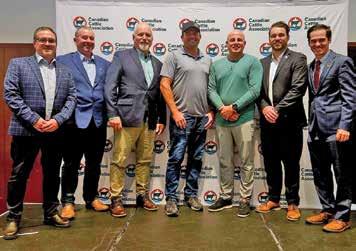
Thank you to Abbey Taylor of Belmont, Ontario for sharing this cover photo! You can read more about Abbey and her acceptance into the Canadian Cattle Young Leaders Program on page 5. In this issue, we explore the latest news in the Ontario beef sector, from innovative practices to international milestones. Learn how Brad and Amy Bourbonnais are Raising the Bar with VBP+ and read about the annual Cow-Calf Management Tour and its visit to eastern Ontario - showcasing farms, families, and the latest in herd management. On page 28, discover how the Van Osch family champions sustainability, balancing soil, cattle, and community stewardship. You will also find important updates on the check-off increase and a celebration of 10 years of Ontario beef in Japan.
Don’t miss out on submitting your photos for our December issue. Please send your winter-inspired photos by November 15 to be considered for the cover. Digital photos in portrait orientation that are at least 300dpi are preferred, and can be emailed to info@ontariobeef.com.
ONTARIO BEEF • Beef Farmers of Ontario 130 Malcolm Road, Guelph, ON N1K 1B1 • Phone: 519-824-0334 • Toll Free (for Ontario callers only) 1-866-370-BEEF (2333) Fax: 519-824-9101 • info@ontariobeef.com
EDITOR
LeaAnne Wurmli
CIRCULATION COORDINATOR
Charlene Yungblut
ADVERTISING MANAGER
Cathy Lasby, Preferred Agri-Marketing Services
Guelph, ON Phone: 519-763-8833 • Fax: 519-763-8833 pams@sentex.net
DESIGN and LAYOUT
Prism Studios Advertising and Design Inc. Guelph, ON
PRODUCTION and PRINTING
Beck’s Printing Services, Brantford, ON
PROVIDING A FORUM FOR THE ONTARIO BEEF INDUSTRY
Ontario Beef is the official publication of the Beef Farmers of Ontario. Contents of this publication may be reproduced only by permission of the Editor and with credit acknowledged.
Opinions expressed herein are those of the author and/or editor and do not necessarily reflect the opinion of the Beef Farmers of Ontario. Publication of advertisements does not constitute endorsement or approval by Ontario Beef or the Beef Farmers of Ontario of products or services advertised.
Advertising deadlines are January 10, April 15, July 15, September 15 and November 15. The publisher reserves the right to refuse or cancel any advertising, including advertising that is inconsistent with BFO’s Sponsorship Policy, available at www.ontariobeef.com. Every effort is made to ensure the accuracy of material published, however no responsibility can be assumed for advertising not received in clear, type-written form.
Canadian Publications Mail Product Sales Agreement Number 0040007029
POSTMASTER: Return undeliverable Canadian addresses to: Beef Farmers of Ontario, 130 Malcolm Road, Guelph, ON N1K 1B1

By Craig McLaughlin, BFO President info@ontariobeef.com
• www.ontariobeef.com
fall rolls in and the combines hit the fields, we’re shifting gears into one of the busiest seasons of the year. Harvest means long days, plenty of dust, and the occasional wrestling match with a stubborn piece of equipment that “worked fine yesterday.” For beef farmers, autumn is more than just harvesting crops, it’s a time to evaluate feed supplies, make pasture management decisions, and prepare cattle for the colder months ahead.
Speaking of colder months, starting November 1, Ontario’s checkoff rate will increase from $5.50 to $7.00 per head. Of this, $4.50 will remain with BFO to fund programs and activities, support the Ontario Beef Market Development Program, and maintain daily operations. The remaining $2.50 is a mandatory national levy collected to fund research and marketing initiatives on behalf of the Canadian beef industry. This change stems from discussions last year and our AGM, where voting delegates supported the increase with a 92 per cent approval rate. You can read more about the check-off collection and remittance process on page 8.
The past few months have been very busy, with many opportunities to represent Ontario beef farmers at local, provincial, and national levels, and I’m pleased to share the highlights in this article.
On the national stage, in August, I attended the Canadian Beef Cattle Check-off Agency annual meeting in Moncton, New Brunswick. Throughout September, I participated in several Canadian Cattle Association (CCA) activities. As chair of the Food Policy Committee, I joined meetings leading up to and during the CCA Semi-Annual Meeting in Levis, Quebec, as well as the Foreign Trade and Animal Health & Care Committee pre-meetings. Following Alberta’s announcement urging for CCA reform, I connected with my
BFO BOARD OF DIRECTORS 2025
Craig McLaughlin (Eastern Director) – President
Phone: 613-504-1863 • Email: cmblackhorse@gmail.com
Jason Leblond (Northern Director) – Vice President
Email: jacres5@gmail.com
Don Badour (Cow-Calf Director)
Email: don.badour@gmail.com
Don Hargrave (Cow-Calf Director)
Email: dchargrave@gmail.com
Jim Whitley (Cow-Calf Director)
Email: modelaranch@hotmail.com
Joost van der Heiden (Background Director)
Email: jcvdheiden@hotmail.com
Nick Martin (Feedlot Director)
Email: nickolas@pureislandbeef.com
Jairus Maus (Feedlot Director)
Email: ellengowanfarms@gmail.com
Tom Kroesbergen (Feedlot Director)
Email: tomkroes50@hotmail.com
Denise Byers (Southern Director)
Email: byersdimmick@yahoo.com
Ralph Eyre (Director-At-Large)
Email: ralph@eyrefarms.ca
Kim Jo Bliss (Director-At-Large)
Email: kimjobliss@gmail.com
Emily Bromley (Youth Director)
Email: fondoak@live.ca
BFO STAFF
Executive Director
counterparts across the country for productive discussions on leadership, governance and engagement within CCA and across Canada. Collectively, we have formed a provincial members’ working group to determine a path forward, and I’m optimistic about maintaining unity within the cattle sector heading into next year. As my father would say, it’s not about the horse you choose to ride but riding the horses to the same destination is what really counts in the end.
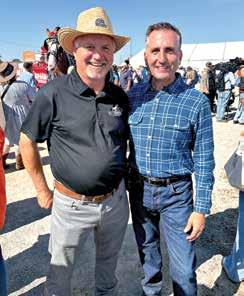
Here at home, I was pleased to attend the Cow-Calf Management Tour - kudos to our Producer Relations team for organizing another excellent event. I also attended the International Plowing Match and
Richard Horne • richard@ontariobeef.com
Manager of Policy and Issues
Thomas Brandstetter • thomas@ontariobeef.com
Senior Policy Advisor
Evan Chaffe • evan@ontariobeef.com
Policy Advisor
Aynur Izzettin • aynur@ontariobeef.com
Director of Communications
LeaAnne Wurmli • leaanne@ontariobeef.com
Manager of Public Engagement and Digital Strategy
Jennifer Kyle • jennifer@ontariobeef.com
Engagement Coordinator
Charlene Yungblut • charlene@ontariobeef.com
Member Information Coordinator
Jamie Gamble • jamie@ontariobeef.com
Accountant
Amber McIntyre • amber@ontariobeef.com
Office Manager
Lisandra Lima • lisandra@ontariobeef.com
Manager of Producer Relations & Director of the Ontario Beef Youth Alliance
Jaclyn Horenberg • jaclyn@ontariobeef.com
Senior Producer Relations Advisor
Dan Ferguson • dan@ontariobeef.com
Producer Relations Specialist
Robert McKinlay • robert@ontariobeef.com
Manager of Compliance
Chris Millar • chrism@ontariobeef.com
Supervisor of Provincial Programs
Barb Caswell • barb@ontariobeef.com
Rural Expo in Grassie with Richard Horne and Thomas Brandstetter, where we had quality time with Ministers Jones, Flack, Thompson, Oosterhoff and MPP Jordan to talk about our pitch for a government guarantee under our Beef Breeder Co-operative Program. Wearing my CCA director hat, I also participated in a Quebec Beef Day in the Pontiac region, which was a great opportunity to strengthen relationships with producers in another province.
On the policy and outreach front, I led our webinar, Managing Dry Weather on Livestock Farms, which was hosted in partnership with OMAFA and Agricorp, I participated in meetings regarding Ontario’s Risk Management Program, joined Richard at a Provincial Red Tape Reduction consultation in Elora, and took part in BFO’s Social Impact Committee discussions. I also attended a Presidents’ Council meeting at the Ontario Federation of Agriculture office in Guelph.
In early October, I travelled to Ottawa for an Ontario fly-in lobby day, and to attend CCA’s annual advocacy reception on Parliament Hill. During these meetings, we connected with senators, ministers, members of parliament, staffers and other key stakeholders to discuss trade, U.S. relations, business risk management programming and emergency preparedness for the cattle sector.
As we settle into the fall, I look forward to meeting with our local association members at our regional meetings that will be held across the province beginning in mid-November. If you have any concerns or issues that you would like raised at these meetings, I encourage you to contact your local advisory councillor and/or president and request them to bring forward for discussion.
It has been a full schedule, but one that reflects the importance of keeping Ontario’s beef farmers represented at every level. From grassroots events to national decision-making, I remain committed to ensuring our sector has a strong and effective voice.
Beef farming: Only for the brave. OB

AbbeyTaylor of Belmont, Ontario was announced as a finalist of the Canadian Cattle Young Leaders (CYL) Program.
The annual CYL Selections Competition took place on September 9, 2025, at the Canadian Cattle Association’s (CCA) Semi-Annual Meeting in Levis, Quebec.
During the competition, impressive semi-finalists from across Canada, involved in various roles within the beef supply chain, competed for a spot in the 2025 mentorship program year.
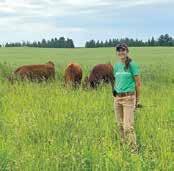
Through the Selections Competition, semi-finalists rotated through discussions with their peers at six roundtables, each facilitated and judged by representatives from the program’s sponsors and industry. Semi-finalists put their skills to the test during thought provoking discussions about timely beef industry topics such as education, succession planning, leadership, public trust, innovative technology and international trade.
Abbey and each finalist will be awarded a $3,000 budget for beef industry travel and learning opportunities, and will be paired with a hand-picked industry leader for a nine-month mentorship in their specific area of interest. OB
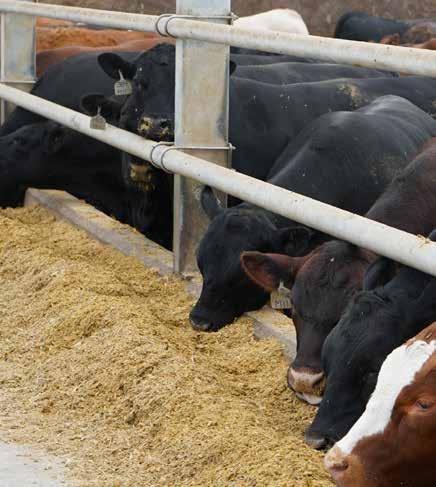

By Thomas Brandsetter, BFO Manager of Policy and Issues thomas@ontariobeef.com • www.ontariobeef.com
hard to believe it’s already fall! Summer seemed to fly by, due in part to the number of events members of BFO’s policy team attended. With both provincial and federal elections having taken place earlier this year, elected officials were eager to meet with constituents at barbecues and community gatherings across the province. The season also brought a wave of announcements from both levels of government.
On the federal side, the Government of Canada announced in June an increase to the maximum compensation values for cattle under its animal compensation regulations to better reflect current market values. The Canadian Food Inspection Agency (CFIA) conducted a market analysis that showed cattle values have risen significantly since the last update in 2015. The amendment to the Compensation for Destroyed Animals and Things Regulations (CDATR) now means cattle producers affected by a reportable disease may be eligible for up to $16,500 in compensation for registered or purebred cattle (up from $10,000) and up to $10,000 for non-registered cattle (up from $4,500).

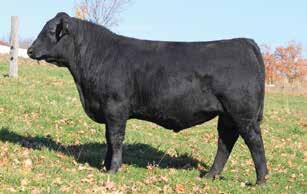
GLEN ISLAY TENDERLINE 3K [TENDERNESS SCORE 10] • SEVERAL SONS AVAILABLE
The bull calves are weaned, looking really strong, and genomically tested either 9 or 10 for tenderness.
Now is the time to reserve your bulls for 2026, and we will semen test them and deliver them when you want them. No one ever regretted buying quality.
DON & JEANNETTE CURRIE
2234 Conc. 11, R R #1, Nottawa, Ontario L0M 1P0
Phone/Fax: 705-445-1526
Cell: 705-715-2234 • Email: doncurrie@glenislay.com
The Government of Ontario also recently announced a $41 million investment over four years for Agricultural Research and Innovation Ontario (ARIO). ARIO’s vision is to drive high-impact, transformational agri-food research that strengthens Ontario’s agricultural and food sectors. This funding includes support for the new Ontario Poultry Research Centre, similar to the Ontario Beef Research Centre that opened in 2019, as well as for the new Ontario Feed Innovation Centre at the Elora Research Station. Additional funding will go toward repairs and upgrades across the research network to ensure the continuation of cutting-edge work that benefits farmers and agri-businesses throughout the province.
In early September, Lévis, Quebec hosted the Canadian Cattle Association (CCA) semi-annual meeting, which is an excellent opportunity for BFO directors and staff to engage with their counterparts from across Canada. Committee meetings on Environment, Food Policy, Animal Health & Care, Foreign Trade, and Domestic Agriculture provided valuable updates on issues relevant to our members. Discussions covered topics such as emergency management and foreign animal disease preparedness, business risk management programs, market access, trade negotiations, and environmental stewardship initiatives.
We also attended the tri-national meeting with leaders from the CCA, the National Cattlemen’s Beef Association (NCBA) in the United States, and Confederación Nacional de Organizaciones Ganaderas (CNOG) in Mexico. This forum allows the three associations to share insights on trade policy, and to discuss common challenges and opportunities facing beef producers across North America.
Looking ahead, November will be another busy month on the policy front. The Government of Canada is set to table its first budget since April 2024 on November 4, while the Government of Ontario is expected to release its Fall Economic Statement mid-month. Although the exemption for Canada-United States-Mexico Agreement (CUSMA)-compliant goods has shielded the beef sector from the ongoing U.S. tariff war, many other industries have not been as fortunate. With trade negotiations and the CUSMA review scheduled for 2026, we’ll be watching closely to see if new programs or funding are introduced to support export market diversification and help offset trade-related impacts.
Also in November, BFO directors and staff will travel to Queen’s Park for our annual Fall Lobby Day. The primary focus this year will be our request for a government guarantee under the Beef Breeder Cooperative Program.
As always, please feel free to reach out to any member of BFO’s policy team for more information about the topics covered in this month’s Beef Beat article, or to discuss any issues affecting you and your operation. OB
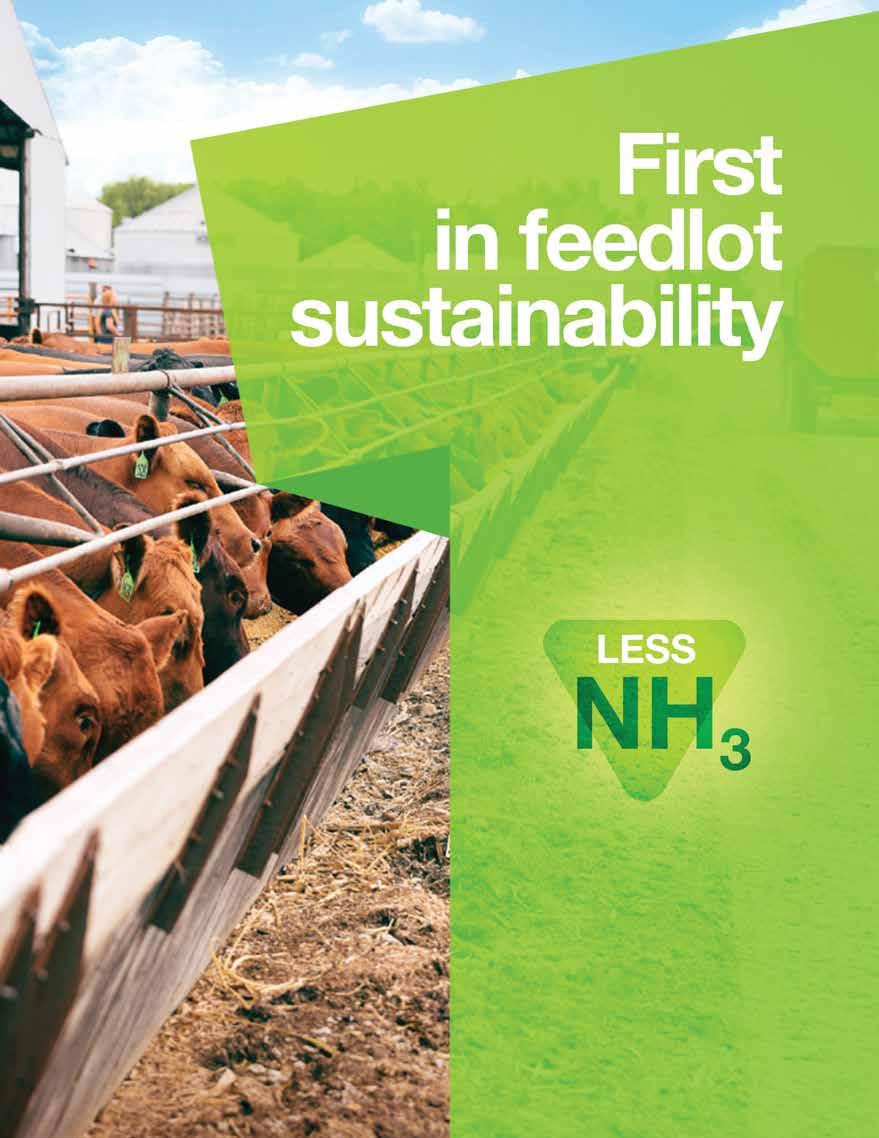

By LeaAnne Wurmli, BFO Director of Communications leaanne@ontariobeef.com • www.ontariobeef.com
Earlier this year, delegates attending our Annual General Meeting in Toronto approved an increase of $1.50 to the national portion of the beef cattle check-off with strong support and a vote of 92 per cent in favour of the increase. Shortly after the endorsement, we began the formal process of requesting that the Ontario Ministry of Agriculture, Food and Agribusiness amend Regulation 54 of the Beef Cattle Marketing Act. Approval was granted in September, and effective November 1, the existing mandatory $1.00 per head federal agency levy will be increased to $2.50, and total Ontario check-off per head will be increased from $5.50 to $7.00 per head.
The check-off system has a long history in the province dating back to its first introduction in 1968. Provincial check-off has been collected since that time at various rates, and the mandatory national check-off of one dollar was first implemented in Ontario in 2008. Prior to that, Ontario voluntarily directed funds to the national organizations to support marketing and research.
Unlike previous increases, this adjustment is primarily about sustaining our ability to effectively maintain services, capacity, and our presence with government and key decision makers. It also helps align Ontario with other provinces and supports our national organizations, whose work we believe brings strong value to our industry.
The new funding will be directed to maintain BFO programming and services, increase support for the Ontario Cattle Feeders’ Association and the Ontario Beef Market Development Program, and increase investment in national research and building trust and consumer confidence in beef and beef farming.
To help our members and industry partners better understand the check-off collection and remittance process, we’ve compiled a list of frequently asked questions, some of which are included in this article. You can find all of this information, along with updated check-off remittance forms, on the BFO website at www.ontariobeef.com. On the following page, you will find an updated private treaty remittance form, which is also newly available as an electronic form on BFO’s website under Check-off. OB
Q. Who has to pay the Ontario check-off?
Regulation 54 of the Beef Cattle Marketing Act states that by law, every cattle seller has an obligation to pay the $7.00/head checkoff. Breeding stock, cull dairy cows and beef calves are included. Exemptions only exist for:
a. cattle sold for the production of milk
b. cattle sold for the production of veal
c. cattle that are owned by a person who does not reside in Ontario - a different rate may apply
The veal and dairy sectors are governed by separate marketing regulations.
Q. Isn’t the check-off collected only when cattle are sold for processing?
No. The $7.00/head check-off is payable whenever cattle are sold, subject to the exemptions cited above.
Q. If I sell my cattle privately, am I exempt from paying the Ontario check-off?
No. Regulation 54 of the Beef Cattle Marketing Act states that by law, every cattle seller has an obligation to pay the $7.00/ head check-off. If cattle are sold by private treaty, the seller is responsible for remitting the $7.00/head check-off on cattle sold. A check-off remittance form can be found on the BFO website and in most editions of Ontario Beef magazine.
Q. Who is responsible for collecting the check-off?
Both the buyer and seller are responsible for collecting check-off. Regulation 54 of the Beef Cattle Marketing Act requires auction market operators, packing plant operators and livestock dealers to deduct the $7.00/head check-off from the proceeds payable to cattle sellers and remit them to Beef Farmers of Ontario (BFO). If cattle are sold by private treaty, the seller is responsible for remitting the $7.00/head check-off on cattle sold.
Q. Are check-off fees subject to HST?
Yes, check-off fees are subject to 13% HST.
Q. How do I remit check-off and when is payment due?
In the vast majority of cattle transactions, it is the responsibility of the buyer to deduct the $7.00/head check-off from the proceeds payable to the cattle seller. Firms that deduct check-off are required to remit the fees to BFO by the 15th day of the following month. A seller must remit the check-off accruing from private treaty transactions directly to BFO by the 15th day of the following month with a statement showing their name and complete address, and the number of head sold. A check-off remittance form can be found on the BFO website and in most editions of Ontario Beef magazine.
Q. I live in Ontario, but I sold cattle out of province. Am I required to pay check-off to BFO?
Yes. The buyer of the cattle is required to deduct and remit check-off in the amount of $7.00 per head regulated by Ontario’s Beef Cattle Marketing Act.
Q. Why does BFO require the names and addresses of the buyers and sellers?
Accurate information of all cattle sellers in Ontario provides a critical tool that enables the verification of BFO membership eligibility and voting rights, aids BFO in response to animal care events and emergencies, and assists in the timely response to major foreign animal disease outbreaks and other serious animal health or public health emergencies. Not only does the timely and accurate submission of seller information assist BFO in carrying out its mandate, it is required by law under the Beef Cattle Marketing Act.
Through the check-off system, beef farmers invest significant dollars in provincial and national initiatives focused on advocacy, policy development, marketing, education and research. Collectors of these funds play a vital role in ensuring their contributions support meaningful solutions to the challenges and opportunities facing the beef sector.
Q. How are my check-off dollars spent?
Check-off dollars are very important and valued by the association. The provincial portion of the check-off ($4.50) remains in possession of BFO to fund programs and activities, support the Ontario Beef Market Development program, and to maintain daily operations. The remaining portion of the check-off ($1.00) is a mandatory national levy collected to fund research, market development and promotion activities on behalf of the Canadian beef industry.
BFO is actively engaged in a range of issues and supports its membership in the following ways:
• Proactive policy monitoring and analysis of issues related to the beef and broader agri-food industry
• Support, dissemination and extension of beef research and development initiatives
• Advocacy activities in support of Ontario beef issues and priorities
• Market information and analysis
• Domestic and export market development
• Programs and initiatives that support:
- producer engagement, education, and leadership
- consumer and public engagement
- industry development, sustainability, and growth
• Targeted and strategic communications through various mediums
Every cattle seller (including sales by private treaty) is required under Regulation 54 of the Beef Cattle Marketing Act to pay a $4.50 per head Ontario license fee and a $2.50 per head national levy, for a total of a $7.00 per head check-off. Breeding stock, cull dairy cows, and beef calves are included. Exemptions exist only for cattle sold for the production of milk and veal (which is governed by separate marketing regulations specific to the veal and dairy sectors). Fees are payable by the 15th of the month following deduction. Licenced Livestock Dealers who sell cattle within seven business days of having purchased them may apply for a rebate with proper documentation.
Firm or Individual Producer Reporting
HST Registration No:
Period Covered by this Report:
a) Number of Head Sold: Finished: Stocker:
Breeding Stock Females: Culls:
Breeding Stock Bulls: Calves:
b) Total BFO Check-off ($7.00xa)
c) HST on BFO Check-off (bx13%)
d) Total Amount Owing (b+c)
Cheque, e-transfers and payment by credit card are all accepted. Please contact the office to arrange payment by e-transfer or credit card. Please retain one copy of this form for your files.
I declare that this information represents a true and accurate statement of check-off deductions required to be made under Regulation 54 of the BCMA and the Canadian Beef Cattle Research Market Development and Promotion Agency.
Date:
Signature:
Print Name:
Address:

By John Baker, Director
of the Ontario Beef Market Development Program john@ontariobeef.com • www.ontariobeef.com
This July marked the tenth anniversary of Ontario beef exports to Japan. The milestone was celebrated with events in Ontario and in Osaka, Japan, during the Osaka World Expo, along with a summer-long promotion in partnership with our flagship retailer, Kinsho Stores.
The celebration began in Ontario with a visit from Kinsho Stores and Prima Meat Packers’ leadership team. They met with the Ontario Corn Fed Beef team at the Ontario Cattle Feeders’ Association office in London to reflect on past successes, discuss challenges, and explore opportunities for continued growth. The delegation also toured four OCFBQA-certified feedlots. A special thank you goes to Dibhurst Farms, Eusi Farms, Al & Marlene Noorloos, and Van Osch Farms for hosting the group, opening their operations, sharing their family stories, and helping us mark this important milestone.
The Ontario visit concluded with a reception at the office of the Ministry of Agriculture, Food and Agribusiness (OMAFA) in Guelph, featuring a video message from the Hon. Trevor Jones, Minister of Agriculture, Food and Agribusiness, and remarks from Deputy Minister John Kelly, who highlighted the strong and longstanding ties between Japan and Ontario.
Celebrations then continued in Osaka, where the city was hosting the Osaka World Expo. A reception at the Canada Pavilion welcomed 80 guests from across the Japanese supply chain and featured speeches from the Presidents of Kinsho, Prima, and Cargill.
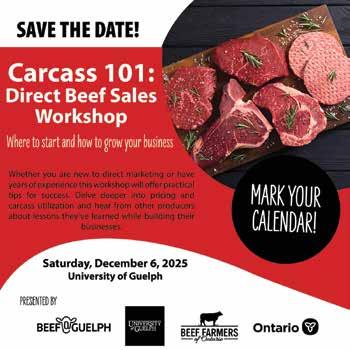
“Since 2015, the Ontario Corn Fed Beef program has been recognized as a true premium beef brand, steadily expanding its sales with the strong support of discerning customers, dedicated retailers, and appreciative consumers. As a result, the brand’s recognition has also grown remarkably,” shared the President of Cargill’s Japan Sales Office.
The brand’s exposure over the years has helped establish new retail partnerships across Japan. Today, seven retail chains, representing 233 stores nationwide, market the Ontario Corn Fed Beef brand.
“Many retail chains in Japan recognize Ontario Corn Fed Beef as the premium brand of Canadian Beef in Japan,” says Daisuke Shimojima, Asia Marketing Manager for the Ontario Beef Market Development program. “As the Japan economy recovers from recession, there is strong interest from many other retail chains that want to have access to Ontario Corn Fed Beef.”
Independent retailers, restaurants, butcher shops, and further processors are key market segments for the Ontario Beef Market Development program. This year, we expanded our capacity to engage more retailers, processors, and local distributors with the addition of Derek Boudreau as Marketing Manager.
Derek brings a wealth of knowledge and strong industry relationships from his background in Ontario’s meat sector. Highly respected within the industry, he offers valuable insights that will strengthen our organization.

Please join us in welcoming Derek to the Ontario Beef team.
Ontario Beef Market Development staff have been travelling across the province to promote Ontario Beef with independent retailers and butcher shops.
“We are working with Ontario packers at both the federal and provincial levels to identify retailers who want to feature high-quality, locally sourced Ontario beef,” says Marketing Manager, Derek Boudreau. “The uptake of our point-of-sale materials has been

very strong. Retailers I’ve spoken with are eager to differentiate themselves by highlighting the quality of Ontario beef and sharing the story behind their local supply. They want customers to know why they’ve chosen Ontario beef for their meat counters.”
Boudreau adds, “I’ve also begun discussions with further processors on developing value-added products such as sausages, snack sticks, and jerky made with ‘all Ontario beef’ as a way to stand out in the market.”
To date, more than 200 branded point-of-sale kits have been distributed to retail stores and butcher shops. If you are interested in receiving a kit, please contact Derek Boudreau at derek@ontariobeef.com.
In addition, No Frills, a leading retail chain owned by Loblaw Companies Ltd., has introduced Ontario Corn Fed Beef in all of its Ontario locations. As a major player in the retail sector, No Frills represents a significant opportunity to grow sales of Ontario Corn Fed Beef and strengthen demand for Ontario-fed cattle.
Incoming trade missions provide an excellent opportunity for our global customers to see firsthand how Ontario beef farming families raise some of the best beef in the world.
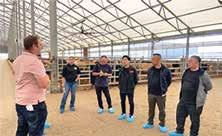
Visitors gain a deeper understanding of how high-quality, nutritious feed grains are grown on the farm, the care and expertise that go into handling cattle, and the management practices that ensure cattle are healthy and well cared for.
Recent visitors shared the following impressions:
“Now that I have experienced how Ontario farmers raise their cattle and the high-quality feed ingredients they produce, I have a better understanding and appreciation of how they are able to produce such great beef.” - Head Chef Saradhi Dakar, The Maine Group, Dubai
“I have sold imported beef for many years in Japan, but this is the best quality we have found.”
“We are excited to tell the story of how Ontario Corn Fed Beef farmers raise their cattle and to promote the best beef from Canada in our stores.” - Chief Meat Buyer Masaru Takai, Sogoh Mart, Matsuyama, Japan
This year, we hosted a group of retail executives from Japan and will welcome three additional delegations this fall: another retail
group from Japan, one from Saudi Arabia, and one from the United Arab Emirates. The Saudi Arabian and UAE groups will include worldclass chefs, retail meat buyers, and distributors.
A special thank you goes to all the producers who volunteered to host our guests, open their farms, and showcase their passion and commitment to quality.
The Ontario Beef Market Development Program has been active on the tradeshow circuit again this year. Tradeshows provide an important platform to raise awareness of our brands and showcase Ontario beef to target audiences in both local and international markets.
Participation in these events is a key component of our market development efforts. Tradeshows allow us and our industry partners to engage with stakeholders, identify new customers, and highlight the high quality of Ontario beef.

So far in 2025, we have participated in four major events, with one more significant show to come:
• Japan Supermarket Trade Show, Tokyo: This event attracts over 50,000 visitors, including buyers and managers from the Japanese retail supermarket sector.
• Gulfood, Dubai: The largest food show in the Middle East, drawing buyers and managers from across the Gulf region. Ontario Heritage Beef and Ontario Corn Fed Beef were promoted in partnership with distributor Simply Gourmet.
• Restaurants Canada Show, Toronto: Held in early April, this year’s Ontario Beef pavilion featured four brand partners.
• Flanagan Foodservice Show, Ontario: In late April, the event showcased Carve Premium Ontario Beef, sourced from cattle certified under the Ontario Corn Fed Beef Quality Assurance program, and attracted Flanagan’s customers from across the province.
Looking ahead, Grocery Innovations Canada (GIC), Canada’s largest retail-focused trade event, will be held in Toronto this October. This event brings together key decision-makers from independent and chain retailers nationwide. This year, three Ontario packer partners will join us in the Ontario Beef pavilion, providing multiple opportunities for retailers to establish consistent supply chains of high-quality Ontario beef.
With increasing competition from imports, maintaining awareness of our local supply capabilities is critical. More import competitors are targeting the Ontario market, making it essential for us to remain visible to industry partners and demonstrate our commitment to growing and sustaining our market share. OB

be formally inducted on Saturday, November 8, 2025 at a ceremony in Victoria, British Columbia.
TheCanadian Agricultural Hall of Fame announced the names of the agricultural ambassadors who will join the ranks as the organization’s 2025 inductees. John Anderson, Dori GingeraBeauchemin, Gaétan Desroches, Joe Hudson, Dennis Laycraft and Dr. Peter Sikkema will
helped guide the industry through a number of defining moments, among them: the development of the national check-off, the BSE crisis, the launch of the Verified Beef Production program, and Canada’s evolving role in global trade.
One of the biggest long-term wins, he noted, was “working together across the country to build a shared voice.” Whether through the Canadian Roundtable for Sustainable Beef or coordinated export strategies, Canadian producers have shown what’s possible when grassroots leadership meets national collaboration.
That same spirit continues to drive today’s efforts — from defending science-based regulation to expanding market access and strengthening public trust in beef sustainability.
Dennis was nominated by the Canadian Cattle Association. OB
“Every year we welcome inductees who have made impactful contributions across so many segments of Canada’s agriculture industry,” says Canadian Agricultural Hall of Fame Chair Phil Boyd. “As our industry continues to innovate and advance, it’s important to reflect and recognize the lifetime contributions these individuals have made to strengthening the world-class agri-food industry we enjoy in Canada. Our 2025 inductees reflect groundbreaking work in primary production, value-added and food retail, policy making, commodity organizations, cooperatives, research and extension.”
Dennis Laycraft is a lifelong champion for Canada’s beef industry who has made an indelible mark on many critical aspects of today’s industry. For more than 40 years, his patient leadership style at the Canadian Cattle Association has been opening and defending markets, and building critical capacity as he continuously drives Canadian trade and competitiveness interests. As a skilled collaborator, Dennis has played key roles in many initiatives including the Canadian Roundtable for Sustainable Beef, Canada Beef and the new Agricultural Market Access Secretariat. He’s mentored many to ensure the industry’s export capacity and competitiveness are built on preparation, principles and quick action.
Laycraft began his leadership career in Alberta with the Alberta Cattle Commission before stepping into a national role in 1990. He

This workshop is open to producers raising veal and dairy-beef, providing essential insights into organ condemnations and their impact on herd health, feeding efficiency, and overall production. Each condemned organ is more than a loss — it signals potential health concerns, nutritional gaps, and management inefficiencies that could be limiting animal performance. By understanding what condemnations truly represent, producers can identify preventable diseases, refine feeding strategies, and enhance animal care to ensure optimal growth and market readiness.
Thursday, November 6, 2025

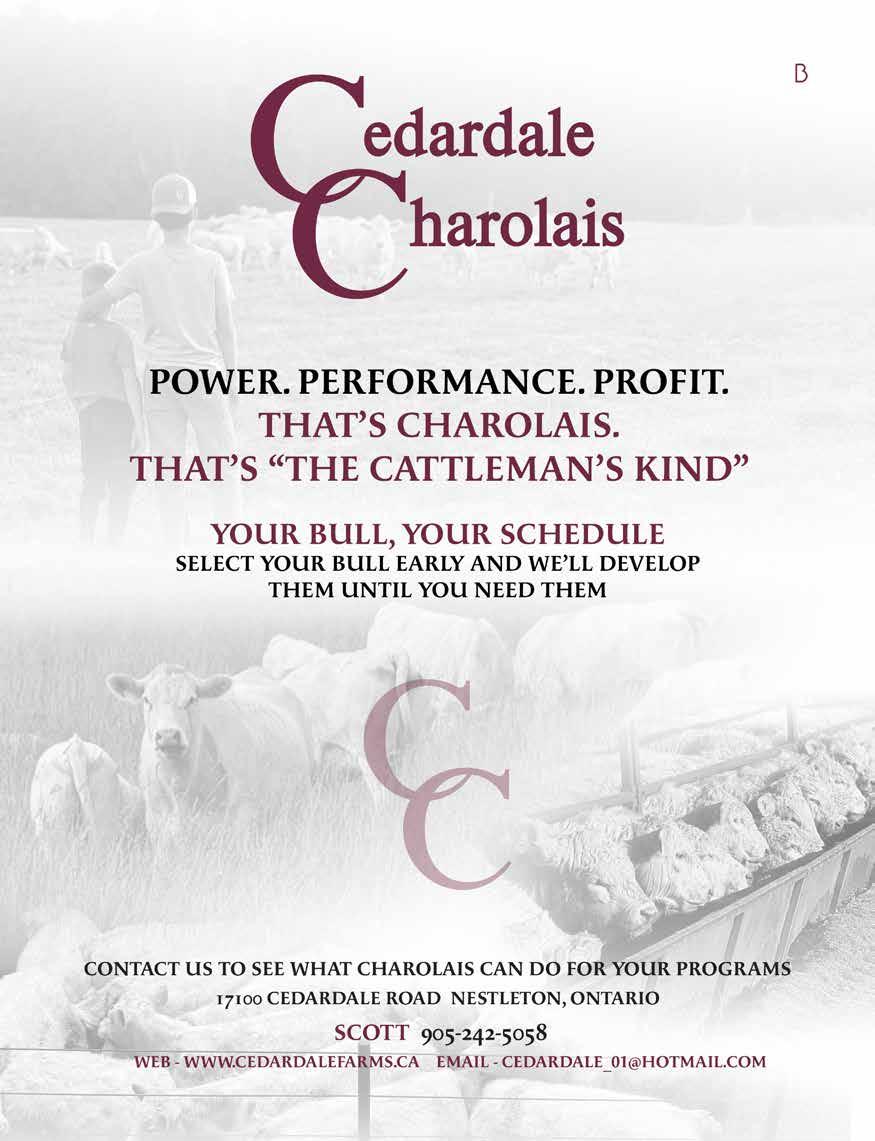
By Jaclyn Horenberg, BFO Manager of Producer Relations
Cow-Calf Management Tour
hit the road on August 22-23, bringing together more than 80 enthusiastic participants along with sponsor representatives. The Lennox & Addington Cattlemen’s Association and the Beef Farmers of Frontenac were excited to welcome the group as we travelled throughout the countryside for the two-day tour.
The tour began in Napanee, where guests gathered at the Hampton Inn before boarding the bus to the first stop at Bayview Farms. The Windover family operates a mixed farm with commercial beef cows, hay, soybeans, and wheat. Their beef herd is made up of Gelbvieh cows bred to a Charolais bull, with a focus on producing high-quality calves that perform well in the feedlot.
During the visit, Brian Windover highlighted the importance of colostrum in setting calves up for success and spoke about the value of building connections within the industry. He shared how something as simple as logoed ear tags led to a lasting business relationship with a feedlot operator who now consistently purchases their calves. Brian also explained how the Verified Beef Production Plus (VBP+) program aligns with their farm’s values and supports consumer confidence by meeting the standards of the Canadian Roundtable for Sustainable Beef (CRSB).
The Windovers are committed to environmental stewardship through rotational grazing, water management, and partnerships with organizations like Ducks Unlimited. Participants also had the opportunity to review sample VBP+ records, see the farm’s Bud Box cattle handling system in action, and take in the display of three generations of tractors.
Our next stop on the tour was a visit to Kennedy Farms, a purebred Red Angus operation, owned by the Kennedy family. Ted and Sarah Kennedy, along with their children Carson and Maeve, focus their genetic selection around easy-doing cows that work well with their off-farm jobs. Carson explained the bull selection
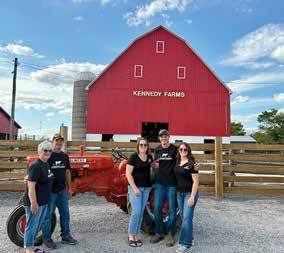


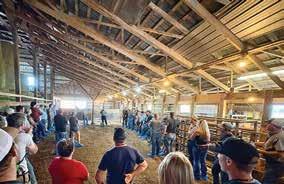
process and how they market their cattle. Succession planning and the future goals for the farm were also discussed with Carson and Maeve both weighing in on their aspirations for the farm. This hard-working family showcased the value of working together and developing a cow herd to suit their management style.
The final stop of the day was at Burns Farms, where Terry Burns welcomed the group alongside four generations of his family. Terry explained their 800head backgrounding operation, which sources calves locally in Ontario and sells to a consistent buyer. His father, Paul, emphasized the importance of building strong relationships within the Canadian beef industry.
A wagon ride tour showcased the visible impacts of the dry year and drought. Terry highlighted the value of Ontario’s Risk Management Program (RMP) as a vital tool for managing risk in the beef business. He also encouraged cow-calf producers to ensure calves are properly castrated, dehorned, and vaccinated, and to communicate this clearly when marketing calves. Strong communication between sectors, he noted, can improve calf success through the feeding period while reducing the need for preventative health products in the feedlot.
After the conclusion of the tour, the group gathered for a delicious supper catered by The Blue Door Café, enjoyed in a rustic setting of the barn. Special thanks go to the members of the Lennox & Addington Cattlemen’s Association for their efforts in hosting the meal and providing warm on-farm hospitality.
To close out the first day, participants took part in a panel discussion on the Living Lab projects. Evan Chaffe explained that Living Lab is a five-year innovation initiative that brings together farmers, organizations, researchers, and other experts to co-develop, test, and evaluate beneficial management practices aimed at addressing climate change challenges in livestock and cropping systems.
He was joined by producer participants Mike Swidersky and Adam Shea, who shared their experiences with the project’s focus on cover crops. They explained that four farm sites are involved in comparing grazed and ungrazed cover crops planted after winter wheat and before corn, assessing cover crop yield, forage quality, subsequent corn yield, and soil health indicators such as active carbon, compaction, and nitrogen availability.
By demonstrating how cover crops can serve as both livestock feed and a tool for improving soil health, the project aims to promote regenerative agriculture, increase cover crop adoption, and provide valuable data on the economic and environmental impacts of grazing cover crops. Both Mike and Adam emphasized the importance of participating in research, especially when it can influence government and policies affecting producers. You can learn more about the Living Lab projects on the Ontario Soil and Crop Improvement Association (OSCIA) website.

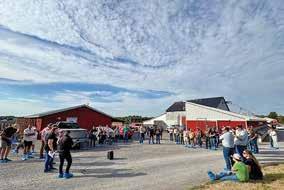
The second day of the Cow-Calf Management tour began at River Valley Polled Herefords, where siblings Donald and Pauline Embury welcomed participants. They shared insights about their beef operation as a seedstock producer with 140 cows and their broader enterprise, River Valley Poultry Farms Ltd., which includes eight layer barns, four pullet barns, and over 1,000 acres of land.
Donald and Pauline highlighted their focus on beef genetics, proudly showcasing their sale ring area and sharing the story behind each banner hanging on the walls. Participants toured the barns and viewed the heifer and bull development yards, where the Emburys prioritize producing high-quality cattle that perform well in the field. Both emphasized their passion for the cattle business and the strong relationships they have built over the years.
The Cow-Calf Management Tour was approved as a Knowledge Sharing Event (KSE) for the On Farm Climate Action Fund (OFCAF) program delivered by OSCIA. Barb Keith, Member Service Representative with OSCIA, spoke at River Valley Polled Herefords about the OFCAF program, success stories from previous funding periods, and future funding options for beef producers.
The tour continued at Bert Hughson’s farm, where participants were treated to a glimpse of his lifelong passion for antique cars and one-of-a-kind collectibles housed across multiple buildings. Bert shared stories about his collections and welcomed the group to explore his memorabilia. His farm manager, Frank Goodfellow, spoke about the development of their commercial Charolais cow herd, emphasizing the focus on easy-tempered cows.
For the next session, participants split into two groups for presentations by guest speakers Gary Brown from Cargill Animal Nutrition and Cailyn Barton. Gary discussed nutrition and management strategies during drought years, highlighting
the importance of a quality mineral program, forage sampling, and the use of creep feed to support cattle under dry conditions. Meanwhile, Cailyn, with assistance from Dave Perry and his cattle, guided participants through evaluating cattle conformation. She explained how conformation affects longevity in the herd and what to look for when selecting heifers and bulls.
The tour concluded with a delicious lunch hosted by the Beef Farmers of Frontenac.
On behalf of BFO, we extend our heartfelt thanks to all participants for making the Cow-Calf Management Tour such a success! We are grateful to the farm hosts for generously welcoming producers to their operations and sharing their production practices and hospitality. Thank you as well to the speakers for sharing their knowledge and expertise. This event would not have been possible without the support of our many sponsors, who continue to invest in the Ontario beef sector. We sincerely appreciate everyone who helped make this event possible and look forward to seeing you next year!




By Chad Mader, Beef Cattle Specialist, OMAFA and Cate Thompson, Summer Student, OMAFA
use of beef (primarily Angus) sires in the dairy industry has become common practice in recent years. These Angus X Holstein, or ‘Beef-on-dairy’ (BOD) cattle are now part of the cattle feeding supply chain. As this is still a relatively new sector of beef production, the Ontario Ministry of Agriculture, Food and Agribusiness (OMAFA) conducted a project this summer to collect information from producers. The goal was to identify current industry practice for raising BOD cattle, keys to success, common challenges, and lessons that could apply to the broader beef sector. While one summer is certainly not enough time to fully answer all questions, this article will summarize our observations to this point.
BOD calves and grain-fed veal calves are generally managed in the same manner until weaning, which occurs for both at approximately eight weeks of age. These protocols are based on the extensive experience that the veal sector has in the business of raising calves. BOD calves appear to be hardier than their straight Holstein counterparts, which is not surprising - the idea of crossbreeding and hybrid vigour is not a new concept. Upon entering the feedlot system (generally at 600-1000 pounds, depending on specific operations), BOD cattle are managed similarly to their conventional beef counterparts. The most variation is in the way calves are managed during the ‘growing phase,’ between weaning and feedlot entry.
This becomes apparent when we look at nutrition strategies post-weaning. At weaning, calves are generally on a veal starter/ grower-type ration, with a small amount of forage – often straw. From this point, there are producers that transition through a series of low-forage rations (never more than 20 per cent forage) right through to harvest weight. Some introduce more forage after weaning and transition calves to a forage-based total mixed ration (TMR) that would be typical of conventional beef backgrounding diets. Others fall somewhere in between. Corn silage is the most common forage source, but hay, haylage, straw, or some combinations are all being used successfully. There is variation in forage levels of finishing diets as well, but this is not unique to the BOD sector. Forage level in finishing rations varies based on operator preference, feed availability and logistics. This is true for all feedlots – whether they are finishing BOD or conventional beef – or both.
Producers have raised some concerns, including inconsistent yield, the prevalence of ‘dark cutters,’ and increased health challenges during the growing phase. However, within the scope of this project, none of these issues were reported frequently enough to indicate any clear trends. In the United States, there is ongoing discussion about a high incidence of liver abscesses in BOD cattle.
It is noteworthy that this project found no evidence of this trend in Ontario. While liver abscesses, when they do occur, tend to be more severe in BOD cattle compared to conventional beef, there is no indication from this project that BOD cattle fed in Ontario are more likely to experience liver abscesses than other fed cattle.
For anyone feeding (or considering feeding) BOD cattle, there are a few factors worth considering. The supply of BOD calves is relatively consistent year-round, versus the seasonal nature of conventional beef. This can be attractive to some producers, but does not lend itself well to an ‘all-in, all out’ system. While the performance and muscling of BOD cattle typically fall between conventional beef and straight Holstein, it has been shown that, due to the nature of Holstein genetics, BOD cattle tend to be more uniform than conventional beef, which can provide some management advantages.
As it appears, a wide variety of nutritional management strategies can be successful when feeding BOD, and therefore, providing industry-wide recommendations is not likely to be useful. Like many situations in the beef sector, the best approach for any given producer depends on their specific situation. If you grow or have access to a supply of high-quality forage, you may want to consider higher forage levels in your diets. If your goal is to maximize the number of cattle you can produce, higher grain levels will likely shorten your days to market. For those who are not raising the cattle all the way from weaning to harvest, the ration preferences of the other feeding operations involved may influence your ration choices. Different strategies should be considered for those feeding heifers, as they are more likely to become overconditioned. Working with a nutritionist is always recommended, but especially in an evolving sector such as this, producer feedback will help the nutrition community learn as well.
When BOD cattle became a regular part of the cattle feeding sector, it was suggested that they would require a high-grain diet throughout their lives. While that does appear to be a viable option, observations from this project suggest that higher-forage rations can also be successful. As is often the case in the beef sector, there are a variety of ways to make this work. Producers are encouraged to consider the goals of their operation, as well as their specific situation. Feed cost can vary depending on what you produce yourself and what you need to purchase – be that grain or forage. Availability of by-product feeds, forage prices in your area, labour availability and many other variables unique to your operation will impact cost of production. There is likely not one ‘right,’ solution, but you should look for the right solution for you. OB
Maximize your marketing by buying Canadian Angus bulls and participating in the Canadian Angus green tag program. When you buy your Angus bull, insist on the registration papers, and be sure they are transferred in your name.
Canadian Angus cattle present a balanced genetic profile in terms of calving ease, growth, and quality carcass merit. They are versatile animals that work well in both purebred and crossbreeding programs.
When Canadian Angus bulls are used in crossbreeding programs they contribute to low birth weights, valuable maternal traits, and moderate frame size to replacement heifers.

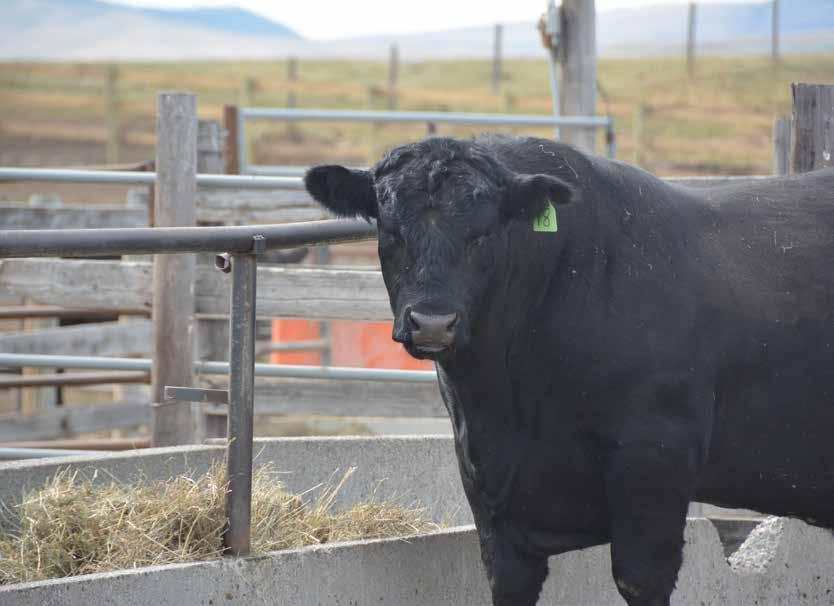
Visit the Ontario Angus Association website for more information and to find listings of Ontario purebred sales: www.cdnangus.ca/ontario-angus-association
Contact any of the breeders below to arrange for your private viewing of cattle for sale.
Cairnlee Acres
Victor, Yvonne & Andrew Richardson
6193 Walkers Dr, Strathroy, ON Vic Cell: (519) 871-4240
Cambray Livestock Company
Luke, Matt, Joe and Carl Jewell 1153 The Glen Road, Woodville ON 705-934-2853
Fallis Land and Cattle
Mike, Lisa and Cole Fallis 1273 6th Line, Selwyn, ON K9J 6X5 705-740-4878 | sunsetacres@nexicom.net
Gilchrist Farms
Brad & Kristie Gilchrist 1269 Grey Ox Ave RR#5 Lucknow, ON N0G 2H0 519-440-6720 | brad@gilchristfarms.com
Glen Islay Angus
Don Currie
2234 Conc 11, Nottawa, ON L0M1P0 705-715-2234 | doncurrie@glenislay.com
Loval Farms
Scott & Sandra Honey 127 Honey Road, Warkworth, ON K0K 3K0 705-924-3809 | lovalfarms@gmail.com
Harprey Farms
Allan Hargrave/Don Hargrave 307483 Centre Line A Proton Station, ON N0C 1L0 Allan 519-375-5541 | Don 519-375-1500 harprey@gmail.com
Maple Line Farm
Ian & Tim Rudkin 3320 Bradburn Road, Blackstock, On L0B 1B0 Ian 905-718-5331 | Tim 905-213-6518 maplelinefarm@hotmail.com
Meadow Bridge Angus JJ Deslippe 922580 Rd 92 RR # 4, St Mary’s, ON N4X 1C7 519-275-1739 | meadowbridge14@gmail.com
Rob Roy Angus
Don & Betty McNalty 634514 Road 63 RR#2 Singhampton, ON N0C 1M0 705-446-4740 | robroyangus@gmail.com
SCOMAC Livestock
Scott & Elizabeth MacDonald 4169 Highway # 6 Hagersville, ON N0A 1H0 Scott 519-820-1272 | Elizabeth 226-971-0015 scomaclivestock@gmail.com
Silver Springs Farm
James, Joan, Robert and Emily McKinlay 609027 12th Sideroad RR#1 Ravenna, ON N0H 2E0 519-599-6236 | jmckinlay@bmts.com
Tullamore Farms
Bill & Sylvia Jackson 260 Regional RD 39 Zephyr, ON L0E 1T0 Cell 647-990-2697 tullamore.angus@gmail.com
Whiskey Lane Livestock
Scott, Paula, Jason & Shelby Cornish 2295 Hwy 7, Indian River, ON K0L 2B0 705-341-3220 | wll@nexicom.net
Windcroft Farms
Darcy & Courtney McMorris 573333 Boot Jack Ranch Road
Priceville, ON N0C 1K0 226-203-4506 | windcroftfarms@gmail.com
Worth-Mor Cattle
Kyle, Rachel, Jordyn and Mason Petherick 950 County Rd 8 Campbellford, ON K0L 1L0 705-768-3560 | worth-mor@hotmail.com

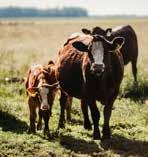

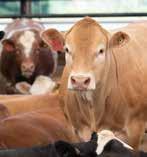

Effective November 1, 2025, the national portion of the check-off will increase to $2.50 per head, while the provincial portion will remain at $4.50 per head. This will raise the total check-off from $5.50 to $7.00 per head.
Through your support, you will strengthen our ability to:
• Sustain services, leadership, and presence with government and key decision makers.
• Advocate for beef farmers at Queen’s Park, in Ottawa, and across the country.
• Support programs like Ontario Corn Fed Beef and the Ontario Beef Market Development Program.
• Boost national investment in research, promotion and building consumer trust.
• Align Ontario national check-off rate with the rest of Canada to support a stronger National Beef Strategy.
• Keep beef on the table by promoting its health, safety, and quality.
Visit www.ontariobeef.com to review our Report Card, updated check-off forms, and more information on the check-off collection and remittance process in Ontario.


SUNDAY, OCTOBER 26,
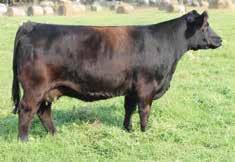
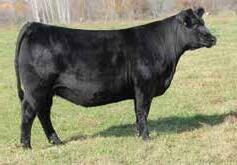
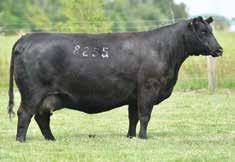

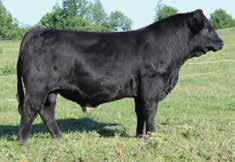
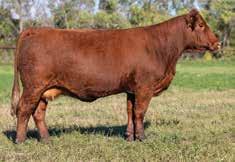


By Beef Cattle Research Council
Canadian beef producers, we take pride in our disease-free status and the global reputation of our livestock industry. Canada has been free of Foot and Mouth Disease (FMD) since 1952, an achievement that has allowed us to maintain valuable export markets and consumer confidence. But this success shouldn’t breed complacency, it should motivate us to stay prepared.
FMD is one of the most contagious animal diseases affecting cloven-hoofed animals, including cattle, sheep, pigs, and goats. While it’s not a threat to human health or food safety, an outbreak would be economically devastating. An FMD outbreak in Canada could cost between $22.6 billion and $75.8 billion depending on outbreak size, severely disrupting animal and meat product exports to international markets.
The disease is currently present in 77 per cent of the global livestock population across Africa, the Middle East, Asia, and limited areas of South America. The FMD virus was recently detected in parts of Europe normally free of the disease and the continent is now experiencing its worst outbreak since 2001. With increased global travel and trade, the risk of introduction is real, making prevention and preparedness essential.
The absence of FMD in Canada creates the perfect opportunity to learn and prepare without the pressure of an active outbreak. Emergency preparedness isn’t about expecting disaster - it’s about being ready if it happens to limit the damage, just like car insurance. Understanding FMD helps protect our livelihoods and industry.
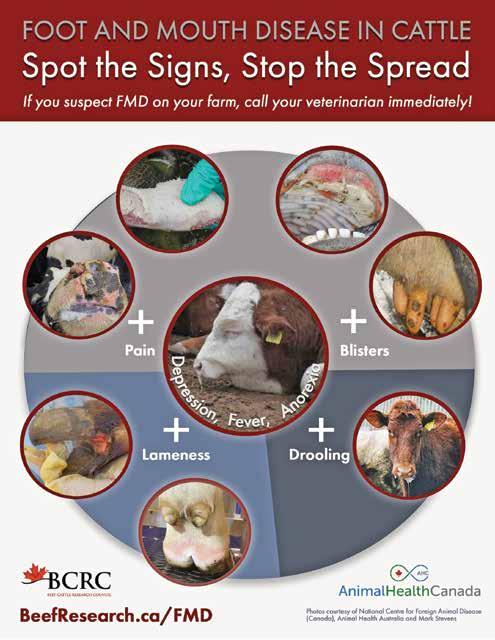
Recognizing FMD symptoms could be the difference between containing an outbreak and facing industry-wide devastation. Key signs include fever, depression, excessive drooling, lameness, and blisters on the mouth, teats, and feet. Animals may also show reduced feed intake and milk production.
If you suspect FMD, immediately stop all animal movement and contact your veterinarian. Early detection and rapid response are critical to limiting the spread and economic impact. It’s better to call and be wrong than it is to ignore symptoms that could lead to a multibillion-dollar cost to our industry.
The FMD virus easily hitchhikes on contaminated surfaces, making vehicles, equipment, and footwear prime carriers of the disease between farms. The virus can survive on inanimate objects (called fomites) and organic material for extended periods.
Doing these things can significantly reduce risks:
• Make it a habit to wash vehicles, trailers, equipment, and boots when moving between operations. Anything that comes into direct contact with soil, manure, and animal areas where the virus
Continued on page 22.

concentrates create a direct pathway for disease spread across multiple operations. Someone walking or driving through an infected area can carry millions of virus particles to the next location.
• Keep track of who’s coming and going on your operation and set some basic rules for farm visitors. You can implement appropriate precautions (such as boot change or vehicle wash) based on the visitor’s recent activities. Detailed visitor logs enable rapid identification of potentially exposed farms, allowing authorities to implement containment measures quickly and prevent further spread.
• Keep accurate records of animal movements and farm activities. Without accurate records of where your animals went (sales, shows, other farms), investigators lose precious time reconstructing animal movements in the case of an outbreak which allows the disease more opportunity to spread. Complete records enable faster implementation of movement controls and quarantine zones, preventing further spread while maintaining industry operations in unaffected areas.
These measures work together as layers of protection - if one fails, others provide backup security to protect your herd and the broader industry.
• wait appropriate periods before contacting animals upon returnfive days from any country, or 14 days from FMD-positive regions.
The Beef Cattle Research Council, with support from Animal Health Canada, has developed practical materials specifically for Canadian beef cattle producers. These include videos, graphics, travel guidelines, and a symptoms poster are all designed to help you understand, prepare, and respond effectively. Find them at www. beefresearch.ca/FMD.
Our FMD-free status is a collective achievement requiring ongoing vigilance from every producer. By taking time now to understand the disease, implement preventative measures, and prepare response plans, we protect not just our individual operations but our entire industry. OB
If you suspect FMD, immediately stop all animal movement and contact your veterinarian. Early detection and rapid response are critical to limiting the spread and economic impact.
For those traveling internationally, especially to FMD-positive countries:
• avoid livestock contact abroad,
• don’t bring back cured or uncured meats, wool or hide,
• clean and disinfect clothing and footwear, and

The Beef Cattle Research Council (BCRC) is Canada’s national industry-led funding agency for beef, cattle and forage research. The BCRC’s mandate is to determine research and development priorities for the Canadian beef cattle industry and to administer Canadian Beef Cattle Check-Off funds allocated to research. Visit www.BeefResearch.ca to learn more.
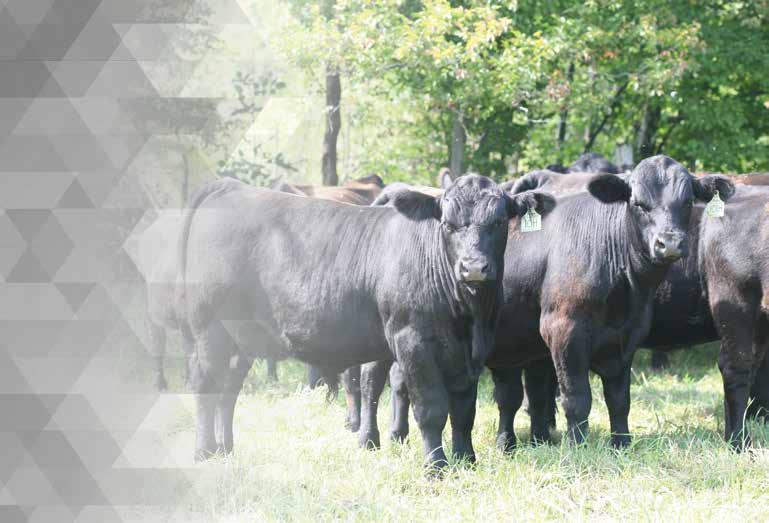
Transform your herd’s records into powerful decisions with Performance Testing for bulls and heifers and the Stock Record Exchange (SRE). SRE is a new service to

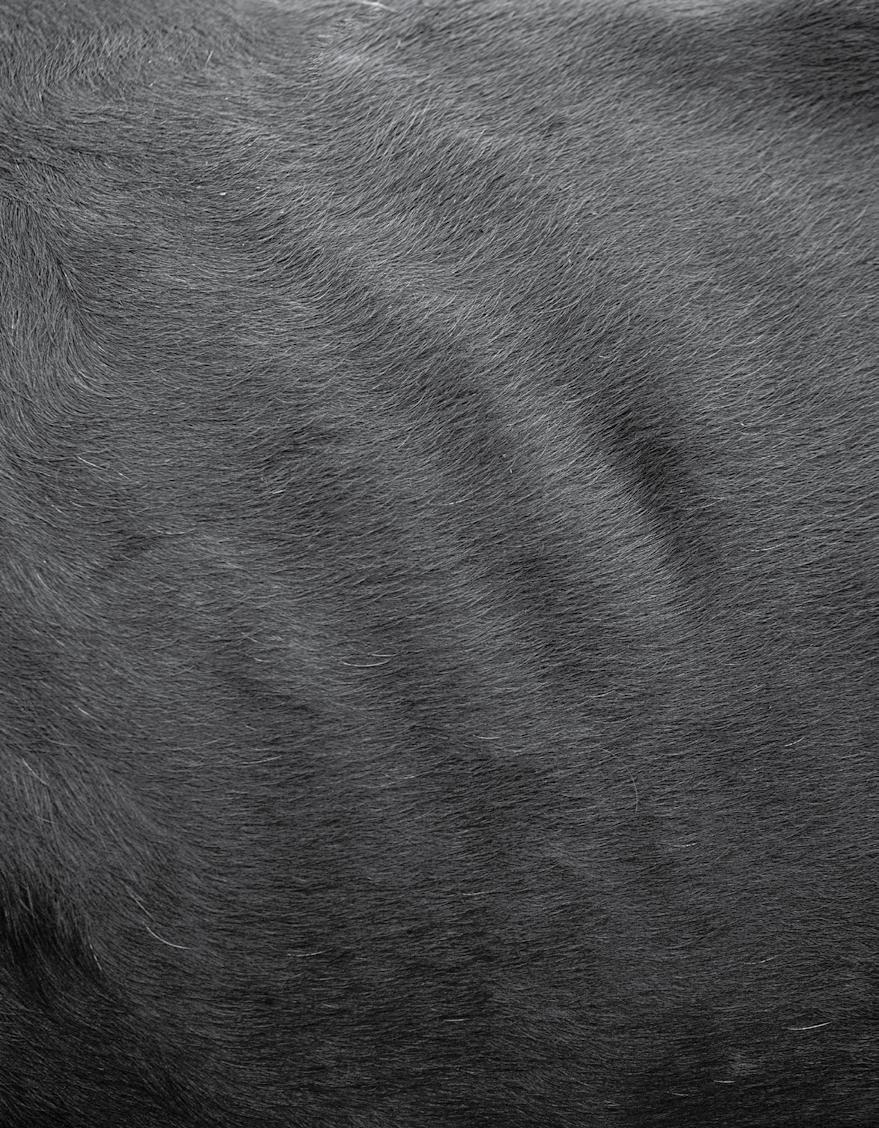
Brad and Amy Bourbonnais didn’t change how they raised cattle, they simply proved their commitment to sustainable beef production by becoming VBP+ certified.
By Jeanine Moyer
Stormont County beef producers Brad and Amy Bourbonnais approach farming with a ‘why not?’ attitude – an outlook that drives them to ask questions, be more accountable, more efficient, and to raise the healthiest beef in the most sustainable way possible. That’s why joining the Verified Beef Production Plus (VBP+) program just made sense because it fit right in with how they already farm.
The Bourbonnais have been raising beef since 2016 and certified VBP+ since 2022. Today, they farm in Monkland, Ont., raising 75 cowcalf pairs while backgrounding their own cattle and offering custom feeding for backgrounders. They manage their herd on their home farm and across several local pastures. Situated along a busy highway, the couple are accustomed to curious passersby who stop at the roadside, or even pull into the farmyard, to ask questions.
“We’re always happy to answer questions about our operation and the way we raise our beef, and we love to share that being VBP+ certified is part of our story,” says Amy. “It’s funny how the certification has given us an extra boost of confidence in how we raise our livestock and manage our land, proving that we have thought through and planned everything we do with purpose.”
The goal of the VBP+ program is continuous improvement and giving producers credit for what they are likely already doing. The VBP+ standard isn’t designed to add significant cost or workload to a producer’s plate, but Brad points out, the program has provided new ideas for on-farm improvements.
Throughout the training, on-farm auditing and annual check-in process, Canadian producers are able to ‘prove’ they are raising their cattle using the highest standards for food safety, animal care, social responsibility, and environmental stewardship.
VBP+ also helps producers prove that they are doing the right things by offering both training and third-party auditing to certify operations under the program standard. On-farm assessments, resources and training are available for operations in the cow-calf, backgrounding, and feedlot sectors from coast to coast. Getting certified also qualifies cattle for marketing in sustainable supply chains sought after by select retailers.
For the Bourbonnais, the VBP+ certification process began when the couple attended a one-hour training session hosted by BFO that explained the program’s expectations and requirements. Brad says it was during that session that they both realized they were already doing many of the program’s expectations.
“I think there’s a misconception about the program among producers,” says Amy. “Especially when we talk about the auditing and assessment portion of the program. The reality is, most Ontario beef farmers are already following many of the recommended practices, and this certification offers a framework for those practices
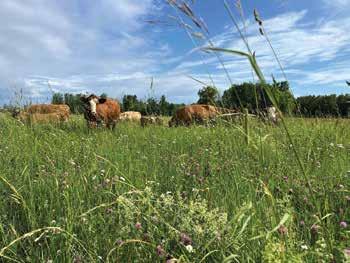
to connect producers to consumers with trusted, quality and sustainable beef.”
Brad assures fellow producers that their experience with the VBP+ audit felt like more of a conversation at the kitchen table with another beef farmer who asked questions and gave the couple the opportunity to showcase their farm and their passion. “We came away with recommendations for enhancements that we took with open arms and have since upgraded some of our practices, namely record keeping and organizing our animal health supplies.”
Looking back, Amy says the time they invested into the training, assessment and auditing process was minimal. Especially when compared to the time savings they’ve realized since streamlining some of their management processes. She estimates it took them a day’s effort for all three activities (training, assessment and audit), plus an hour answering questions and submitting records once at year at the annual check-in.
“It was during the assessment process that we realized record keeping and paperwork were a weak point in our operation, but the fix was simple, and ironically, we were able to leverage a cost-share
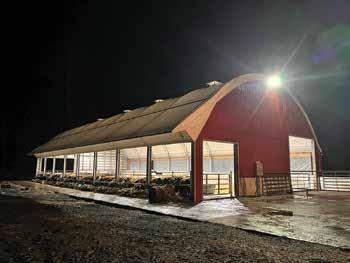
incentive to upgrade our equipment to make it all that much easier,” she says.
The couple believe the opportunity to review their farm on an annual basis has been a significant benefit for their operation and its sustainability for the future. Not only did the VBP+ certification process challenge them to take a wholistic view of their farm, and in many cases reassured them they were doing a great job, but it has given them more confidence, especially as young beef producers.
“VBP+ isn’t just about how you raise your animals, it’s a Canadian brand and an investment in your farm’s sustainability too. The program has challenged us to integrate resiliency and risk management measures that will continue to pay off,” says Brad, pointing to their upgraded record keeping system that would be essential in the event of an animal health or biosecurity issue.
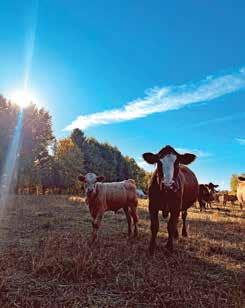
Amy is quick to point out there’s no judgement throughout any part of the VBP+ process. They’ve always had a positive experience working with the BFO and VBP+ program coordinators and value their shared commitment to improving their operation.
Amy admits the program has made them step back and really think – about what they’re doing now and what they want for the future.
“You get out what you put in,” says Amy. “If you’re curious, honest and open to new ideas you can get a lot from the program.”
Brad explains that participating in the program hasn’t been about gaining financial benefits, but the ability VBP+ provides them to brand their beef and provide consumers with a level of assurance that they are meeting the highest standards when it comes to animal welfare and sustainable practices.
Being a certified VBP+ producer means the Bourbonnais participate in an annual check in to maintain their status that requires them to complete yearly record submission requirements to prove they are still in compliance with the program. According to the couple, the process is simple and straightforward. Program participants are also required to answer a series of questions as part of the annual check in, which Amy says she enjoys because it gives them the opportunity to reflect on the previous year and evaluate their progress.
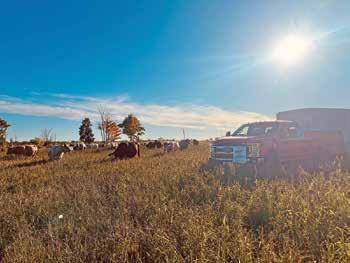
Currently, the initial program verification and annual renewal fees are being subsidized by BFO. The organization offers a 100 per cent rebate for first time VBP+ audit fees paid by members who become certified through the completion of the training, and an on-farm audit. For producers renewing their VBP+ audit, BFO provides a rebate of 75 per cent on audit fees.
An additional on-farm audit is performed every five years as part of the program renewal. The couple says they went into it with an open mind and asked a lot of questions. “Because we want to continuously learn, improve and demonstrate our accountability” says Brad.
“I believe the VBP+ program will be important for the future of beef production in Canada,” says Amy. “It’s an opportunity to positively position beef farmers, showing our accountability to our animals, consumers and our environment. And most importantly, this program demonstrates just how serious we are about caring for our cattle, environment and our country’s food security.” OB
In addition to the VBP+ Program, Ontario feedlots have the option to be certified under the Ontario Corn Fed Beef Quality Assurance Program through the completion of training, assessments and an on-farm audit. For more information, please contact John Baker at john@ontariobeef.com.


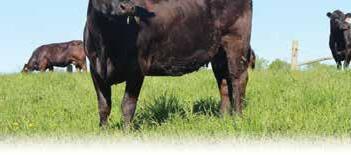

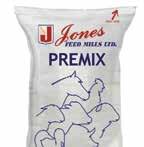




By Lee Hart for the Canadian Cattle Association
TheVan Osch family is in the business of producing high-quality beef on their third-generation southern Ontario farm, but they’ve learned over the years that beef production doesn’t happen without also looking after the soil and protecting the natural resources, which are the foundation of their sustainable farming operation.
“Environmental considerations can take more time and aren’t always the cheapest option,” says Brendon Van Osch who along with his cousin Kurt and their respective dads, Fred and Gerald, own and operate Van Osch Farms Ltd., in Middlesex County, northwest of London, Ontario. “But in the long run proper land and livestock stewardship practices contribute to a more productive and profitable farming business.”
“If the soil is productive, that certainly contributes to a more efficient cattle feeding operation,” says Brendon. “And if your cattle are properly housed and fed, that optimizes overall beef production. We apply the best practices we can to our cropping operation as well as to animal welfare.”
Their commitment to the environment and sustainable farming practices earned Van Osch Farms recognition as the Ontario recipients of The Environmental Stewardship Award (TESA) for 2025.
The farm was started by Harry and Paula Van Osch, who immigrated to Canada from Holland in 1954 and settled in the Crediton area. They started out in the dairy business, but later, as two of their children, Fred and Gerald, got involved, the farm transitioned to a beef feedlot in the late 1970s.
Today, with Brendon and Kurt joining the operation, the farm includes an 11,500-head capacity feedlot as well as 10,000 acres of annual cropping. Along with the Van Osch family, the farm also employs 15 people.
In 2020 (during the COVID-19 pandemic), working with a local abattoir, Parkhill Meats, they launched an online meat retail business. That was partly so they could source beef for their own use, but also to meet a local demand for quality beef. They further expanded the value-added enterprise in May 2025 as they built a new office that included a new 2,000 square foot on-farm retail outlet selling frozen beef as well as other high-quality, locally made products.
The Van Osch farm sources feeder cattle throughout the year. The majority are dairy-cross calves bought from local producers. They source as many as they can from producers who are certified through the Verified Beef Production Plus program. And, particularly
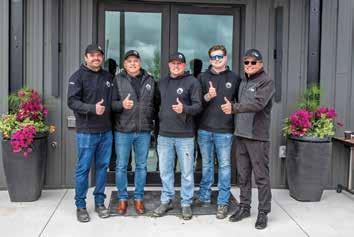

The award was presented in-person by Mike Duguid, Co-Chair of CCA’s Environment Committee and Lisa Miller, Partner, with MNP at the banquet during CCA’s semi-annual meeting. Don and Geraldine Bettle, Passekeag Holdings Inc, located near Passekeag, New Brunswick were announced as the recipient of The Environmental Stewardship Award (TESA) for 2025. Passekeag Holdings Inc was one of seven regional nominees from across Canada vying to be named the national recipient.
in the fall, they bring some feeder cattle in from Saskatchewan and Manitoba. Most calves are within the 500-to-800-pound weight range, although they do buy some 900-to-1,000-pound yearlings in the spring. All are fed through to finishing.
The feeder cattle are fed 100 percent corn-based rations that include high moisture corn, wet distiller’s grain from a local ethanol plant, and corn silage for roughage. Feeders are also supplied mineral mix with a micro pack with all required vitamins and minerals. Calves are fed a four-stage ration. The starter ration has more roughage (silage) and as the ration steps up over the feeding program, they finish with a higher energy ration that still contains some roughage.
Van Osch Farms has developed its own system for housing and feeding cattle through the changing seasons of the year. Feeder calves are distributed across five facilities, each with a large open barn. The cattle are placed in the barns, then separated into pens of 250 to 400 head. Each pen provides feeders with access to inside and outside options as they prefer, all with access to food and water. There are curtains to control airflow on the north side of the barns, with the south side open to the outside cattle yard.
The barns have been upgraded to be more efficient. That includes integrating new technologies like recirculating water bowls to eliminate power use; use of solar powered cameras to monitor feed bunks and minimize feed waste; and a state-of-the-art handling facility. There is additional pen space used to segregate cattle as needed which helps to minimize use of animal health products and improve cattle care and comfort. There are automated controls with remote access to all facilities to ensure barns are being as energy

efficient as possible. The farm also planted about 1,000 cedar, spruce and maple trees as a windbreak around the barns.
The expanse of barn roofs also accommodated an investment in solar panels that are estimated to produce enough energy to supply the annual power consumption of 80 local households, while offsetting 924 tonnes of carbon dioxide emissions.
“We usually have plenty of rainfall and snow, along with hot, humid days in the summer,” says Brendon. “The cattle have their choice to be inside in poor weather or if they want shade, or outside in the yard.”
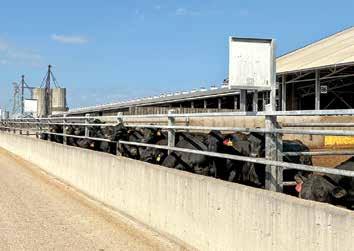

capacity of the soil improves, it helps to prevent runoff into watersheds and improves water quality for aquatic species.
“Without our land base to keep the soil fertile, we wouldn’t be able to sustain our feedlot for future generations,” says Kurt.
Along with applying manure, regular soil testing helps to guide the variable rate application of synthetic fertilizer—applying fertilizer at the proper rate where the crop and land need it. The farm has also established buffer zones between cropland and creeks to protect water quality.
The barn inside pens are well bedded with wheat straw. All of the concrete flooring is grooved to provide good footing. Dry manure and bedding are cleaned weekly out of the barns and put into cement storage bunkers, while the outside yards are slightly sloped which allows the manure to be collected and stored in liquid manure pits.
“We believe that the most sustainable way to produce beef is to maximize our land base to produce the feed for our animals, the bedding for their pens, and to utilize the manure as a valuable nutrient source to improve our soil health,” says Kurt.
Manure management is one of the top priorities on the farm, guided by an Environmental Farm Plan as well as a provincially recognized Nutrient Management Plan. With the capacity to store manure for one full year, manure is applied to annual cropland in summer, usually on winter wheat stubble and incorporated with a tillage pass. With about 4,000 to 5,000 acres seeded to corn most years, the rest of the rotation includes winter wheat, edible beans, and soybeans.
“By utilizing our manure as a nutrient source, we reduce our dependence on synthetic fertilizer while at the same time improving the health and resiliency of our soil,” says Kurt. “We know that the most productive land is the land that has something alive on it. This is why we utilize cover crops between our regular cropping seasons— to feed our second-most important livestock… the critters that call our soil home.”
As the annual crops are harvested, a cover crop blend that includes peas, oats, faba beans, buckwheat, and sunflowers is seeded to protect the soil from wind and water erosion. The legumes add nutrients to the soil, while the rooting systems improve soil texture. As the residue of cover crops is worked into the soil before spring seeding, it contributes to organic matter. As the water holding
John Baker, Director of the Ontario Beef Market Development Program, who works closely with Van Osch Farms, says one factor contributing to the success of the farming operation is their willingness to consult with outside expertise.
“They work with a number of specialists, including an agronomist for crop planning and management of soil fertility,” says Baker.
“And in recent years have worked with Feedlot Health Management Services, now Telus Ag, to provide consulting services on feeder cattle health and nutrition.
“They have also participated in a number of industry programs such as Verified Beef Production Plus, and are certified under the Canadian Roundtable for Sustainable Beef, Ontario Corn Feed Quality Assurance Program. The farm is also involved with the Ontario Soil and Crop Improvement Association and the Ausable Bayfield Conservation Authority. They realize the value of using third-party expertise, programs, and resources to improve the overall efficiency of their farming operation, which helps to reduce their environmental footprint.”
Following a holistic management approach, the farm produces high yielding crops and an efficient and profitable cattle feeding program, while at the same time being home for many species of wildlife such as deer, coyotes, rabbits, fish, several different species of birds, and many other wildlife that are all part of a balanced and efficient ecosystem.
“It takes partnerships and collaboration with specialists and various agencies to enable improvements, and we strongly believe that if everyone is moving forward together, then success takes care of itself,” says Kurt. “We take the sustainability of our farm very seriously and utilize farming practices that ensure the soil and the natural environment are protected for our future generations, as our past generations did for us.” OB
By Canadian Cattle Identification Agency
Livestock traceability is essential for protecting animal and human health by limiting the risks and impacts of disease outbreaks, food safety concerns and natural disasters. Canada’s traceability system is built on three pillars: animal identification, premises identification and movement reporting. However, gaps currently exist, including incomplete species coverage, delayed, inconsistent or lack of movement reporting and outdated record-keeping requirements.
The federal government has proposed changes to Part XV of the Health of Animals Regulations to address gaps in Canada’s traceability system. Key changes include expanding regulated species to goats and cervids, requiring livestock identification, the identification and registration of premises where livestock are kept or collected, and mandatory reporting of animal movements.
The Canadian Cattle Identification Agency (CCIA) is committed to supporting its clients through a smooth transition as proposed regulatory changes approach. CCIA is encouraging both their current regulated species groups (beef cattle, bison and sheep) and pending regulations, cervid and goat groups to begin preparing for the incoming changes and utilizing all the tools available to them in the Canadian Livestock Tracking System (CLTS), which aim to help reduce the administrative burden of the incoming reporting requirements.
The agency recommends CLTS clients verify their Premises Identification Numbers (PIDs) are up to date and registered through their provincial PID registry. Once federal amendments take effect,
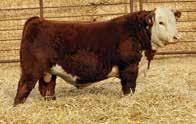
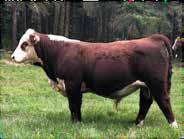


CCIA is working to advance identification and tracking technologies with their research project: The Smart Bolus System as a potential alternative to traditional livestock identification and reporting methods.
Livestock traceability is essential for animal health, food safety and supply chain integrity in Canada. Smart bolus systems offer secure, lifetime identification providing real-time data on an animal’s location, movement and health. Similar in size and weight to rumen hardware magnets, boluses are designed to remain in the animal’s reticulum for its lifetime, removed only during processing.
The ongoing study involves beef calves receiving boluses at four, eight or twelve weeks of age, with researchers assessing retention, ease of application, animal health, automated data collection and real-time movement reporting. Smart boluses transmit encrypted data every 30 minutes to a reader located up to 70 metres away, capturing location, eating and drinking behaviour, and body temperature. Producers can access this information through a software application.
During conveyance testing, the system successfully tracked and reported cattle movements between locations without manual input. All boluses in the trial were retained to date, and the setup of low-cost, preconfigured gateways (small, automated devices that receive and transmit data from the bolus to the cloud for storage and analysis) was straightforward. Results to date indicate boluses are safe, well-tolerated and easily administered to calves as young as four weeks.

“Smart rumen bolus technology has the potential to provide a secure, lifetime identifier for cattle while automating the reporting of location and movements,” said Paul Laronde, Tag and Technology Manager, CCIA. “This innovation could reduce the impacts of tag loss, improve data sharing across the industry and ease the administrative load of complying with the pending traceability movement regulations.”
Beyond identification, the system offers real-time insights to strengthen traceability, verify origin, and enhance animal health monitoring. With advanced software systems under review for efficient data collection and analysis, the project is paving the way for a practical, safe and high-value solution to meet the livestock sector’s evolving traceability needs.





To ease the reporting burden, CCIA’s new movement record module streamlines communication between producers, transporters, and destinations.
Here’s how it works:
1. The source account/premises initiates the movement record in the CLTS.
2. An email notification is sent to the transporter, who inputs relevant details—without needing login credentials.
3. Once the animals are moved, the destination site, account/receiver, confirms receipt of the animals and updates the movement record with its PID submitting it as a Move-In event in the CLTS.
This workflow simplifies the process, reduces paperwork, and ensures compliance with the incoming regulatory requirements. For more information on entering movement records in the CLTS, visit support.canadaid.ca
The movement record module can also be used to report group movements without tag numbers for certain operation types, such as assembly yards or auction marts. It enables collaborative reporting between producers, transporters, and recipients. This creates a live, shared record where each party enters their portion of the movement data, supporting integrated and flexible traceability workflows.
It complements other CLTS features:
• Individual movement reporting still exists and requires tag IDs.
• Users can also report movement events through batch uploads, the CLTS MOBO mobile app, or automated web services for softwareintegrated systems.
Group Movement Specification
• Auction marts and assembly yards are not required to report tag numbers but must include the total number of animals and species.
• Feedlots and other sites must report tag IDs in the Move-In event.
CCIA and national industry associations are working together to ensure industry-wide readiness. From early communication to joint system testing, the goal is to strengthen Canada’s traceability system. Producers and industry stakeholders are encouraged to update their internal systems and protocols to reflect proposed movement reporting responsibilities, take part in CCIA training sessions and workshops, and stay informed as the final regulatory text is published in Canada Gazette Part II (CGII).
Using the movement record in CLTS supports compliance, which protects animal health and producers’ livelihoods. Accurate, timely reporting improves traceability, enabling a faster response to disease events and helping reduce the risk of economic loss. By keeping livestock movements properly recorded, producers can feel confident they are safeguarding their herd, their business and their family’s well-being.
For more information on how to get ready for regulatory changes and explore the new movement record module, visit clts.canadaid.ca or contact CCIA’s support team at 1-877-909-2333. OB
Raising beef is vital to your family, your farm, your community, and Ontario as a whole. The product you raise deserves to reach appreciative family tables close to home, ensuring you receive the best value for your hard work. At VG Meats, we’ve partnered with small beef farmers across Ontario who share our commitment to quality, sustainability, and continuous improvement. Now, we’d like to work with you.
We’re looking to purchase your finished cattle and provide you with valuable data on each animal’s tenderness, yield, quality, and weight. This information not only helps you secure a premium for your beef but also supports better management and genetic decisions for generations to come. By working together, we can help regenerate the lives, profits, and land of Ontario’s beef farming families.

Over the years, we’ve also expanded our connections across Ontario’s retail landscape, creating more opportunities for locally raised beef to reach appreciative consumers. You can learn more about this exciting initiative and how it benefits Ontario farmers at harvesttogather.ca
If your family finishes cattle and you’re ready to explore this opportunity, reach out to me, Cory Van Groningen, at cory@vgmeats.ca, and I’ll share the details of our program. Let’s schedule a time to discuss how VG Meats can help bring your beef to market while supporting your farm’s growth. We look forward to hearing from you soon.





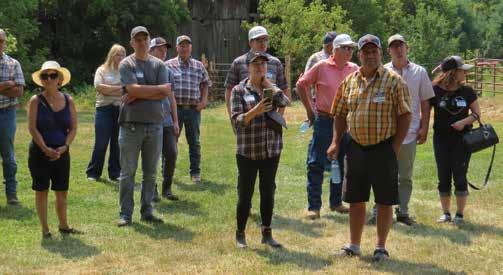

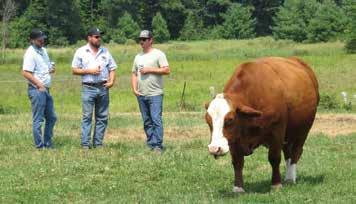
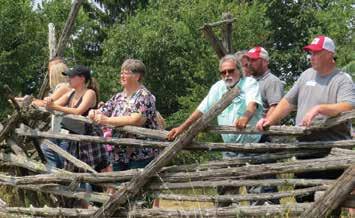

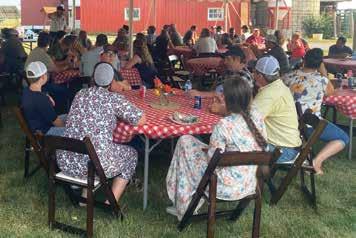

By Tyler Fulton, CCA President www.cattle.ca
The Canadian Cattle Association held its semi-annual meeting in Quebec for the first time in early September. It was also the first meeting in 10 years to take place independently of the Canadian Beef Industry Conference. We were both humbled and impressed by the strong turnout. The Quebec Beef Industry Tour, organized by Les Producteurs de bovins du Québec (PBQ), attracted 80 participants, and 185 attended the banquet.
I wasn’t able to participate in the tour as I was attending the federalprovincial-territorial (FPT) agriculture ministers meeting in Winnipeg, but there was lots of positive feedback about the tour. There was a common thread amongst the comments and the feedback. Producers attend tours and field days in their own provinces and regions all the time—and these are valuable experiences—but nothing compares to venturing outside of your own area to see first-hand the land, environment and conditions that your fellow producers raise cattle in. I’ll never forget the first time that I saw the hills and treed areas on small parcels of land that Quebec beef producers raise cattle in—or the farms and ranches situated in the mountains in BC contrasted with the small sizes of farms in the Maritimes. No matter which part of the country you live and work in, there are advantages and challenges. We are often critical of those outside of agriculture who do not understand what it takes to raise cattle and don’t make an effort to do so, but sometimes when we are caught up in our own day-to-day operations and challenges, we can forget that others face dramatically different conditions and challenges than we do. Listening is a big part of understanding, but being able to walk around and see the cattle and the facilities for yourself is invaluable.
At the banquet, the Canadian Cattle Young Leaders graduation ceremony was held. It is always inspiring and uplifting to see the relationships that have developed between the mentors and mentees and to see an invigorated and excited group of young leaders poised to do great things in our industry.
It was also very inspiring to meet the provincial nominees for The Environmental Stewardship Award (TESA). Don and Geraldine Bettle of Passekeag Holdings Inc, located near Passekeag, New Brunswick are the national recipients. I encourage everyone to get to know all the nominees: Duncan and Jane Barnett of Barnett Land and Cattle in British Columbia; Laura Laing and John Smith of Plateau Cattle Co in Alberta; Mark and Karin Elford of Elford Ranch in Saskatchewan; Clayton and Shauna Breault of Breault Ranching Ltd. in Manitoba; the Van Osch family of Van Osch Farms in Ontario; and Frédéric Lebel and Dominique Dumas of A l’Herbe in Quebec. You can learn more about the program and nominees at www.cattle.ca/sustainability/tesa.
commitment and follow-through when decisions are made. Parliament has resumed for the fall session and we hope to see promises and commitments upheld, particularly for improved and practical business risk management tools such as livestock price insurance (LPI) and AgriStability.
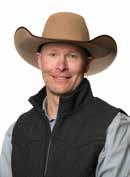
Among the many publications that generously provide CCA with a platform to share information, Canadian Cattlemen Magazine stands out. We have been using this space to offer a deeper look at how advocacy works and how decisions are made. The first article in a fourpart series was published in the August 7 edition and posted online on August 20, focusing on domestic advocacy. If you missed it, you can read it online at www.canadiancattlemen.ca/cca-reports/howand-why-the-canadian-cattle-association-dvocates-for-domesticchange. The remaining columns in the series will cover U.S. advocacy, international advocacy, and market access.
Trade risk and uncertainty continue to prevail in our industry. Market conditions are strong and margins are high which provide an optimal opportunity to enhance tools like livestock price insurance and AgriStability with cost-shared premiums. The increase is significant, and if producers trigger a payment, more of the loss will be covered. Now is a good time to review the programs and plan ahead for 2026.
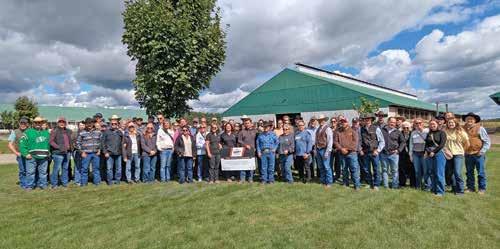
At the FPT meeting, there was lots of discussion about regulatory barriers and interprovincial trade. Discussions are important, as is
Lastly, On August 12, 2025, Alberta Beef Producers (ABP) notified CCA of their intention to withdraw from our association by June 30, 2026. ABP and CCA have a long-standing collaborative and cooperative relationship, and we are both committed to continue working together to benefit beef producers in Alberta and across our country. CCA is committed to working directly with the Alberta Beef Producers and all of our provincial members to address this matter so we can all continue our work for the benefit of beef producers across Canada. We had productive discussions during our meetings and I am optimistic that we can reach an agreement that will see ABP remain part of our national organization. OB
Saturday, November 15, 2025 • Maple Hill Auctions, Hanover, ON or bid online at DLMS Catalogue online at www.ontarioshorthorns.com and Facebook OR contact Blair Williamson: ridgeviewshorthorns@hotmail.com, 519-808-0516.
TIBS SHORTHORNS
Pat Thibodeau Georgetown, ON 416-319-1901 tibsshorthorns@gmail.com
COLDSTREAM FARM
Flesherton, ON
Don Jack: 519-924-1540
Shea O’Neill: 519-373-6599
Heifer, Bulls, Show Prospects Breed Leading EPDs

TRAILVIEW SHORTHORNS
Shannon Kingston & Ross Laycock 1327 6th Av West, Owen Sound, ON 519 477-1526 or 519 372-5414 hockeymama@live.ca
RED ROSE FARM
Martin & Liz Mason & Sons
747710 Twp Rd 4,Drumbo, ON
Cell: 519-771-7066
John Mason: 519-636-6634 martin.mason@redrosefarm.com
GLENROTHES FARM
B1265, Hwy 48 Beaverton, ON Doug Brown: 905-431-8496
Nancy Brown Andison: 416-817-0369
LOCUSTVIEW SHORTHORNS
Steve, Joyce & Dan Bartlett Almonte, ON 613-256-3042 locustviewshorts@outlook.com
Franki Byrne, President - 519-809-5853 email: frank.byrnebbo@gmail.com
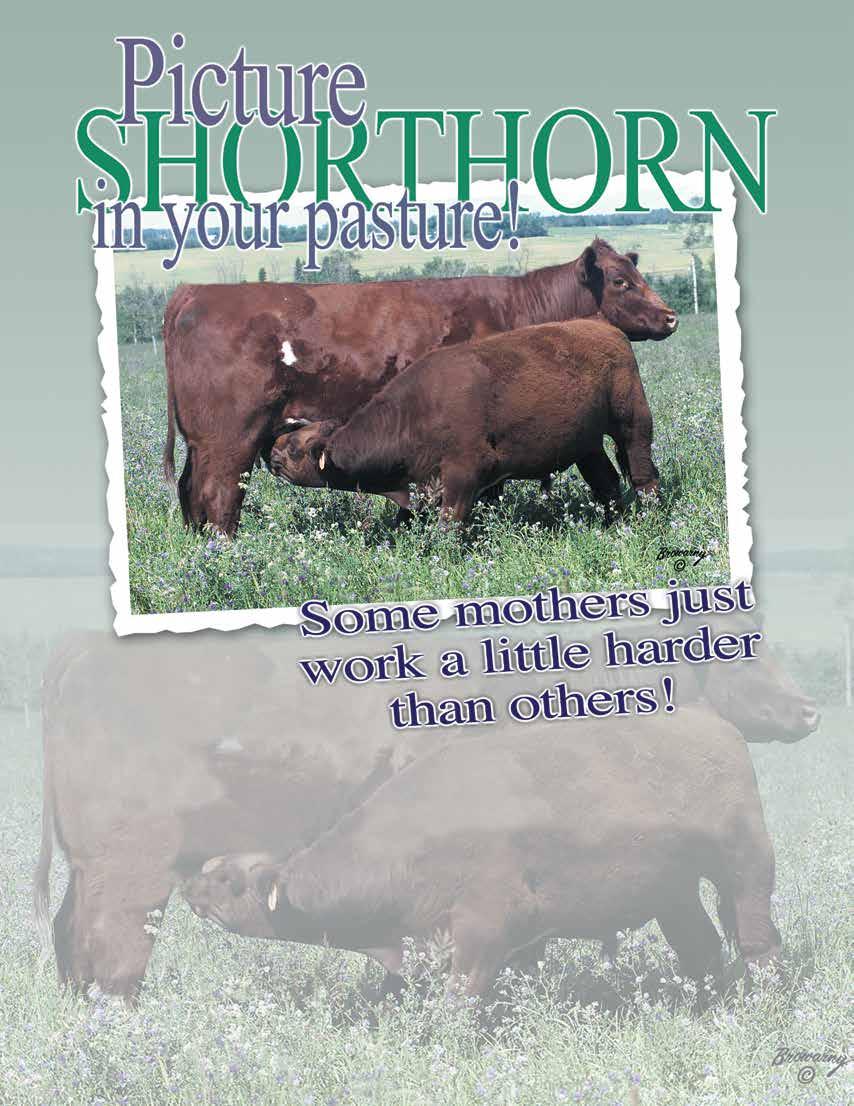
HILL HAVEN FARM
Duntroon, ON
Dale Asser: 705-444-9403
Matt (herdsman): 519-378-5508 hillhavenshorthorns1@gmail.com www.hillhavenshorthorns
MARTIN FARMS
Gore Bay, ON
Jim: 705-348-1294
Nick: 705-348-1022
Alex: 705-782-4725
Bulls, Females, Commercial Cattle
CRAWFDOWN FARMS Glencoe, ON Gord & Sally Crawford 519-870-2396
Reed & Jane,Shelby&Josie 519-857-7333
FLIGHTPATH
Caledon, ON David&Joanne Currie& Family David: 647-400-2844
Jessica: 519-400-3160 farm.flightpath@gmail.com

By Gina Teel, Director, Stakeholder Communications, Canada Beef
is the official start of the second half of Canada Beef’s fiscal year. While the team is busy delivering on the 2025-2026 business plan, initiatives for the next investment plan are starting to take shape, subject to ongoing discussions, shifting headwinds and uncertainties.
With current cattle cycle dynamics indicating a continuation of tight supply for the near future, sophisticated marketing campaigns will be needed to keep beef on the dinner plates of consumers as the cost-of-living climbs higher. Canada Beef looks forward to delivering the Canadian beef story in increasingly impactful ways to further engage and connect with consumers and grow mindshare.
On a related note, Canada Beef welcomed the latest results of annual public perception research conducted by the Public Stakeholder and Engagement (PSE) program. The 2025 research results reported an increase in respondents who viewed beef as an environmentally friendly food choice and greater trust in Canadian beef farmers and the cattle industry, compared with the previous year’s results. The increases in the latter categories were attributed in part to the groundswell of Canadian pride experienced over the past year.
As readers may be aware, the PSE program, jointly delivered by the Canadian Cattle Association and Canada Beef, addresses public facing issues around the environmental footprint of cattle production, and often in collaboration with the Canadian Roundtable for Sustainable Beef’s environmental benchmarking and progress reporting via the National Beef Sustainability Assessment.
Meanwhile, the deployment of the current year initiatives to increase awareness and demand for beef continues at Canada Beef. Here’s a small sampling of the initiatives keeping the team busy this fall.
Canada Beef participated in the International Meat Secretariat (IMS) Human Nutrition and Health Committee meeting in Paris, France in September. In addition to sponsoring a presentation on The Role of Protein Quality in Human Health, Canada Beef presented an update on initiatives underway in Canada to build awareness of iron deficiency among Canadians for health professionals.
Iron is already a nutrient of concern in Canada however new research shows that rates of iron deficiency are even higher than previously reported.
Canada Beef’s Director, Health and Nutrition, Karine Rekunyk, RD, told the gathering of nutrition experts from more than a dozen countries that iron deficiency awareness is often complicated by inconsistent information around how much iron is actually in foods, making finding reliable lists a challenge. She then shared Canada Beef’s efforts to bring some clarity to the situation by developing a list using Canadian government regulatory terms categorising iron content based on labelling claims.
The Canadian Beef Centre of Excellence (CBCE) hosted a consumer marketing content creation session featuring two players from the Women’s Professional Hockey League. Both women aim to play for team Canada at the upcoming winter Olympic games. The athletes shared how Canadian Beef supports their nutrition as high-level athletes, women, and for one, as a mother. The session resulted in content creation for Canadian Beef social media campaigns and mainstream media. Stay tuned.
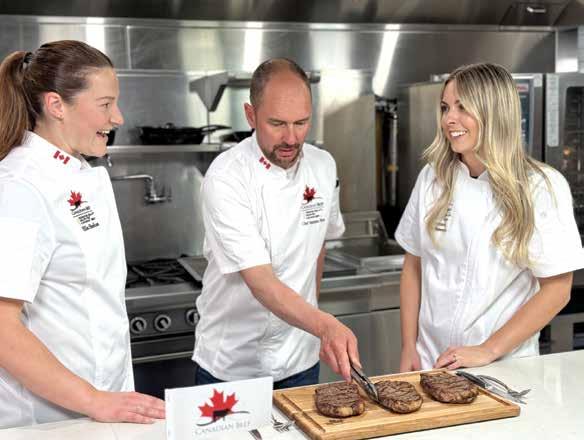
Just prior to Thanksgiving, the third phase of a national advertising campaign will launch in the domestic market. The first half of the eight-week campaign is a continuation of the 5 Reasons to Buy Canadian beef campaign and provides helpful tips to identify Canadian beef at the retail meat counter such as looking for Canadian beef grades or asking the butcher. The latter part of the campaign will focus on the holidays and eating beef in a memorable moments context.
The Channel Marketing team is promoting the Certified Canadian Beef Training Program (CCBTP), following the full program launch in August. The CCBTP’s comprehensive yet approachable curriculum was created in response to industry feedback surrounding
the importance of training and difficulty in finding skilled labour. Educational institutions, retailers, foodservice operators, and distributors can benefit from the CCBTP, designed to enhance Canadian beef product knowledge. Larger organizations can collaborate with Canada Beef to develop customized training content with support from the CBCE.
Canada Beef will participate in the Royal Agricultural Winter Fair in Toronto, Ontario. Planned activities on the fair’s cooking stage include seven Cooking Sessions where participants cook along with top Toronto Chefs and create recipes for two people, and a Dinner Series where participants taste Canadian beef over a three-course meal and execute the Canada Beef Taste Challenge. Social media and promotion of the Best of Canadian Beef Dish Contest for the Restaurant Gateway will be included.
Canada Beef will exhibit at ANUGA 2025, one of the world’s largest international food industry trade shows, in Cologne, Germany from October 4 to 8. Staff will next travel to United Arab Emirates to participate in Canadian beef demand building events in Dubai and Abu Dhabi (October 9 -10) and then to Saudi Arabia to participate in a Canadian beef demand building event in Riyadh on October 12. The

month will wrap up with Canada Beef Vice President, Export Market Development, Albert Eringfeld travelling to Mexico to join various Canadian beef demand building initiatives being arranged in Los Cabos targeting the local foodservice sector from October 22 -24.
Canada Beef leadership will participate in the IMS World Meat Congress in Cuiabá, Brazil from October 27-30, and provide financial support for a Canadian food promotion (including beef) with the Canadian Trade Commissioner service in Saudi Arabia in November.
Canada Beef’s international staff in Japan, Korea, Southeast Asia, and Mexico will be busy promoting Canadian beef at several planned in-market retail and foodservice initiatives and activities such as in-store samplings, online promotions, and restaurant campaigns. Trade show participation, distributor education, and demand building events round out the mix of initiatives to take place over the next several months.
For detailed information on Canada Beef initiatives to increase demand for Canadian beef while ensuring the maximum value for producer dollars, please subscribe to Canada Beef
Performs, follow Canada Beef on LinkedIn and read Canada Beef’s 2024-2025 annual report.. OB


By Lilian Schaer
This fall marks the start of the fifth cohort of a unique mentorship program for early career scientists at the University of Guelph to introduce them to Ontario’s livestock industry.
“When young researchers launch their academic careers, their training has usually emphasized technical skills, data analysis, and publishing papers. What it often doesn’t include, however, is a close connection to the people their work ultimately serves: livestock farmers,” says Kelly Somerville, CEO of Livestock Research Innovation Corporation (LRIC), the organization behind the program.
It was that reality that prompted LRIC to launch its Early Career Mentorship Program faculty mentorship program in 2021. A year later, it was supplemented with an innovative, industry-supported research award for graduates of the mentorship program.
The mission of both initiatives is to give new scientists a stronger understanding of agriculture, the issues farmers face, and the realities of modern livestock production. The goal is simple: help researchers ask better questions, design more relevant projects, and build the long-term relationships between farmers and scientists needed to deliver real solutions with real value on-farm.
Dr. Kelsey Spence, an assistant professor in the Department of Population Medicine at the Ontario Veterinary College, knows firsthand how impactful this experience can be.
She joined the university faculty in 2021, in the middle of the pandemic, and learned about the mentorship program through OVC’s dean, Dr. Jeff Wichtel. Once in-person opportunities returned, she jumped at the chance to take part in the new initiative.
Spence’s research focuses on biosecurity and the complex reasons why farmers and animal owners choose to implement or not implement recommended practices.
Her projects span many species, from equine, sheep, and goats to cattle, dogs, and cats. According to Spence, the questions are the same across species: why do people do what they do, and how can researchers support better adoption of practices that are designed to keep animals healthy and productive.
Because her background is primarily in equine health and epidemiology, Spence says the LRIC mentorship program was invaluable.
“I didn’t know what to expect on that first farm visit, but it was such a good learning experience,” she recalls. “Seeing the variety of farms and getting to meet and speak directly with farmers gave me a much better understanding of how broad agriculture is in Ontario and of the many challenges and opportunities the sector faces.”
It was those first-hand experiences and face-to-face interactions that highlighted why biosecurity adoption isn’t always straightforward.
“When you see the day-to-day reality of a working farm, you understand how complex it is, and how much is constantly going on that puts demands on farmers’ time,” she explains. “That context is critical for designing practical, effective strategies.”
Beyond the farm visits and science communications training, the mentorship provided something equally valuable: connections. LRIC’s team, including Director of Operations, Jean Howden, and former CEO Mike McMorris, has played a pivotal role in linking Spence to people across the livestock industry.
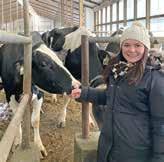
For a researcher who spends much of her time in front of a computer, building those industry relationships and having the chance to ask questions directly to farmers and sector leaders were some of the most important takeaways from her mentorship experience.
Spence’s contributions and potential were recognized this spring when she was named one of two winners of LRIC’s Early Career Researcher Award, which provides direct support to help promising young scientists to advance their research programs in ways that benefit Ontario’s livestock sector.
The $100,000 award is funded by LRIC, Grand River Agricultural Society (GRAS), Western Fair Association (WFA), Ontario Agricultural College and Ontario Veterinary College to encourage cross-sectoral and cross-disciplinary approaches to livestock research.
“LRIC’s support has been instrumental,” Spence says. “The mentorship program gave me real-world context, and the award is helping me build projects that are grounded in the needs of farmers. Together, they’ve made a big difference in how I approach my work.”
Programs like the early faculty mentorship and early career researcher award underline LRIC’s commitment to ensuring research doesn’t happen in a vacuum. By fostering stronger connections between scientists and farmers early in their careers, LRIC is helping ensure tomorrow’s research is relevant, practical, and impactful across Ontario’s beef and broader livestock industries.
For Spence, the experience has been transformative.
“I really enjoyed going to the farms—that was one of the most beneficial aspects, especially coming from outside an agriculture background. It’s something every researcher should have the chance to do,” she says. OB
Livestock Research Innovation Corporation is funded in part by the Sustainable Canadian Agricultural Partnership (Sustainable CAP), a 5-year, federal-provincial-territorial initiative. Food from Thought is a research program at the University of Guelph funded in part by a grant from the Canada First Research Excellence Fund. This article is provided by LRIC as part of its ongoing efforts to report on research, innovation, and issues affecting the Canadian livestock industry.
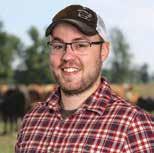
By Daniel Pecoskie, DVM, Metzger Veterinary Services
As feedlot producers bring stocker calves onto their farms in autumn, cases of pneumonia and other respiratory illness often rise. Bovine respiratory disease (BRD) is the term used to describe this group of disease conditions. Rather than being caused by a singular bacterium or virus, BRD develops through the interaction of multiple pathogens with the host (the cow or calf) and the environment (the pens, ventilation, weather, etc.). This means there are several ways in which we can initiate prevention, help reduce the risk of BRD and decrease treatment rates in your group of cattle. Optimal prevention requires cooperation and coordination across all sectors of the beef industry.
Bovine Respiratory Disease is commonly known as pneumonia, bronchopneumonia or “shipping fever”, and affects the nose, throat, trachea, and lungs. It is commonly caused by the bacteria Mannheimia haemolytica, though it often involves interactions with the viruses parainfluenza, bovine herpesvirus and bovine viral diarrhea virus, amongst others. Affected cattle may show increased respiratory rate, shallow breathing, nasal discharge, depression or loss of appetite, a wet productive cough, and fever exceeding 40 °C (104 °F).
Many healthy cattle can carry respiratory viruses and bacteria in their upper airways and lungs, but this alone may not be enough to cause disease. Risk for developing BRD increases during times of stress, when the immune system is unable to maintain baseline health. These risk factors can include:
• Poor quality or no colostrum for calves at birth
• No respiratory vaccine program for cows or calves
• Introducing new heifers, cows or bulls to your herd
• Mixing different groups of calves in the feedlot
• Extremes in weather, temperature and humidity
• Transportation
• Castration, dehorning and weaning
• Acidosis, or abrupt introduction to a high grain ration
Although BRD can be dependent on the time of year and weather conditions, cow-calf producers tend to deal with BRD around the time of calving, especially when there are older calves and cows in the pen with newborn calves. Another common time to deal with BRD in on pasture with summer pneumonia cases. Feedlots typically see the highest incidence in newly arrived stocker calves during the first two weeks, with a possible second spike 30 to 50 days later. The later cases are often linked to
Continued on page 42.
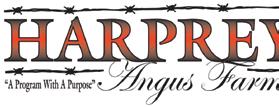



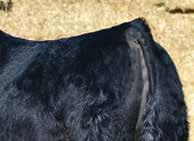
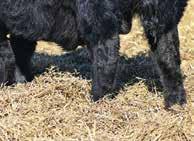

Reported as of September 24, 2025
DEALER TYPE
Auction Market 1001065062 Ontario Inc o/a Hoards Station Sale Barn Brussels
Abattoir 11261991 Canada Inc. o/a H.M. Halal Meat Brampton
Abattoir 1550553 Ontario Inc. O/A Matar Meat Osgoode
Abattoir 2573508 Ontario Inc. Pakenham
Country Dealer 2737927 Ontario Ltd. o/a R & R Farms Amaranth
Abattoir 2833017 Ontario Inc. o/a Henderson’s Meats Chesterville
Country Dealer 33 Mile Cattle Corp Brussels
Country Dealer Alain Bergeron Limoges
Abattoir Albarakah Halal Meat & Chicken Inc. o/a London Quality Meat London
Auction Market Algoma Co-operative Livestock Sales Iron Bridge
Country Dealer Allan Stirling and Marilyn Stirling Little Britain
Country Dealer Alzahraa Halal Meat Inc. Scarborough
Country Dealer Anderson, Stephen Chesley
Country Dealer ANS Livestock Kingston
Country Dealer Aylmer Livestock Springfield
Auction Market Aylmer Stockyards Inc. Aylmer
Abattoir Baghai Development Limited o/a Paradise Farms Toronto
Country Dealer Bateman, Harold Tweed
Abattoir Bentinck Packers Limited Hanover
Country Dealer Besner, Donald Vankleek Hill
Country Dealer Bill Wood and Terri Wood Lyndhurst
Country Dealer Brandon Taylor Warkworth
Meat Packer Bruno's Meat Distribution Ltd. Puslinch
Auction Market Brussels Livestock Brussels
Country Dealer Butch Clare Livestock Burford
Auction Market Cargill Auction Market Inc. Cargill
Meat Packer Cargill Ltd. Guelph
Meat Packer Cargill Meat Solution Corporation Witchita, KS
Country Dealer Chris Rots Enterprises Odessa
Country Dealer Claessens Livestock Inc. St-Simon, PQ
Country Dealer Clarence Poortinga Livestock Inc. Brussels
Country Dealer Clark Bros. Canadian Livestock Inc. Dutton
Country Dealer Cochrane, Ernest Bethany
Country Dealer Darryl Evans Almonte
Country Dealer Deklein Livestock Ltd. Mossley
Auction Market Denfield Livestock Exchange Inc. Denfield
Country Dealer Dewetering, Frank Sebringville
Country Dealer Dickson, Steve Joyceville
Country Dealer Don Sholdice Livestock Brussels
Country Dealer Donald Thompson Farm Trout Creek
Auction Market Embrun Livestock Exchange Ltd. Greely
Abattoir Georgian Bay Meat Packers Inc. o/a Stayner Meat Packers Coldwater
Country Dealer Glenview Livestock Ltd. Wallenstein
Abattoir Gord's Abattoir Inc. Leamington
Association Grey Bruce Livestock Co-Operative Ltd. Owen Sound
Country Dealer Grof Livestock Lindsay
Auction Market Hagersville Auction Centre Hagersville
Country Dealer Hamilton, Allan F. Almonte
Country Dealer Hank Dekoning Limited Port Dover
Country Dealer Hensall Cattle Co. Hensall
Abattoir Highland Packers Limited Stoney Creek
Country Dealer Holstock Farm Ltd Harriston
Abattoir J & J Meat Distributing Inc. Toronto
Country Dealer Jador Beef Chesley
Meat Packer JBS USA L.L.C. Greeley, CO
Country Dealer Jeff McSherry Livestock Farms Teulon, MB
Auction Market Kawartha Lakes Community Sale Barn Inc. Woodville
DEALER TYPE NAME CITY
Auction Market 1001065062 Ontario Inc o/a Hoards Station Sale Barn Brussels
Auction Market Keady Livestock Market Limited Tara
Country Dealer Keating, Glenn Norwood
Country Dealer Kevin Barker Auctions Ltd. Woodville
Country Dealer Kevin Dickson Livestock Joyceville
Country Dealer Kevin McArthur Livestock Mono
Country Dealer Lalonde, Jonathan Val-Des-Monts, QC
Country Dealer Laverty Trucking Mono
Auction Market Listowel Livestock Ltd Listowel
Abattoir L'orignal Packing Ltd. L'orignal
Abattoir Louro Bros. Meats Ltd. Ayr
Country Dealer M & M Livestock Goodwood
Country Dealer Madina Meats Inc. Brinston
Country Dealer Mangan Team Farms Limited. Seeley's Bay Abattoir Manilla Halal Meats Oakwood
Auction Market Maple Hill Auctions Ltd. Walkerton
Country Dealer Mar-Dale Transport (1985) Ltd. Floradale
Country Dealer Martin, Eldon M. Wallenstein
Country Dealer Masen Way Melancthon
Country Dealer McCall Livestock Brussels
Country Dealer Menard & Fils Livestock Inc. Embrun
Abattoir Miedema's Meat Market Ltd. Embro
Abattoir Millgrove Packers Limited Waterdown
Abattoir Milton Fresh Halal Meat Packers Inc. o/a Ontario Halal Meat Packers Milton
Abattoir Mister Greek Meat Market Toronto
Abattoir Montpak International Inc. o/a Viandes Forget Ltee Laval, QC
Country Dealer Nature Calves Ltd Norwich
Abattoir Newmarket Meat Packers Limited Newmarket
Abattoir Norwich Packers Ltd. Norwich
Country Dealer Omer Poirier Livestock Inc. Alexandria
Auction Market Ontario Livestock Exchange Inc. Waterloo
Auction Market Ontario Stockyards Inc. Cookstown
Auction Market Ottawa Livestock Exchange Greely
Country Dealer P.D. Dale Enterprises Ltd. Hanover
Abattoir Parkhill Meats Limited Parkhill
Auction Market Parks Livestock of Ontario, L.P. Milverton
Country Dealer Patricia Taber (TNT Livestock) Mount Albert
Abattoir Peel Meat Packers Ltd. Drayton
Meat Packer Pine Ridge Meat Packers Ajax
Country Dealer Pratten, Kevin London
Assoc Rainy River Cattlemen's Assoc Emo
Abattoir Ralph Bos Meats Ltd. Strathroy
Country Dealer Randy Brubacher and Jeanette Brubacher o/a Bruhill Ag Clifford
Assoc Renfrew Agricultural Society Renfrew
Auction Market Renfrew-Pontiac Livestock Ltd. Cobden
Country Dealer Robert J Campbell Ashton
Country Dealer Robert Rubino Trucking Ltd. Porcupine
Country Dealer Ryan William Leduc o/a SD & G Custom Farming Napanee
Country Dealer Sauder Transport Ltd. Arthur
Country Dealer Schaus Land And Cattle Co. Ltd. Elmwood
Country Dealer Sedore Farms Phelpston
Country Dealer Snyder Livestock Beachburg
Meat Packer St. Helen's Meat Packers Ltd. Toronto
Abattoir Stayner Meat Packers Ltd. Stayner
Country Dealer Sunny Miroca Farms Gananoque
Auction Market Temiskaming Livestock Exchange 1992 New Liskeard
Country Dealer Thames Sales Yard Limited Thamesville
Country Dealer Titan Livestock Inc. Edmonton, AB
Country Dealer Todd Dickson Livestock Kingston
Country Dealer Toll Gate Farm Mountain
Abattoir Townsend Butchers Inc. Simcoe
Abattoir V.G. Meats Simcoe
Auction Market Vankleek Hill Livestock Exchange Ltd. Vankleek Hill
Country Dealer Vernla Livestock Inc. Wallenstein
Abattoir Viande Richelieu Inc. Massueville, QC
Abattoir Walkerton Meat Market Walkerton
Abattoir Weiland Meats Ltd. Petrolia Meat Packer White Veal Meat Packers Ltd. Cookstown
Country Dealer William Haalstra Livestock Dunnville
Country Dealer Willowtree Farm Inc. Port Perry
Country Dealer Wm. D. McComb Inc. Cambridge
Country Dealer Neil Woodrow Courtice
The OBCFPP list is updated regularly and can be found on the Agricorp website. OB
If you buy and sell cattle in Ontario, even part-time, you need a cattle dealer license as mandated under Ontario’s Livestock and Livestock Products Act. This isn’t just a formality; it’s part of making sure the business runs safely and that sellers are protected. Agricorp, the agency that delivers programs on behalf of the Ontario Ministry, handles the licensing and they’ll also help guide individuals through the process.
Being a licensed dealer comes with some real perks. You’re covered under the Ontario Beef Cattle Financial Protection Program, so if a buyer defaults on payment, sellers have a safety net. It also gives you credibility, people know you’re operating legally and professionally.
Basically, if buying and selling cattle is part of your business, you need to be licensed. That includes folks who:
• Buy cattle to resell
• Run auction markets
• Operate packing plants or abattoirs
• Host community livestock sales
Having a licence isn’t just about following the law, as noted above it also gives you access to the Ontario Beef Cattle Financial Protection Program, which helps protect sellers if a buyer defaults on payment.
Getting your licence isn’t complicated. First, you reach out to Agricorp and request the application package. The forms will ask for some basic info about your business, plus financial statements so Agricorp can see that your operation is in a good financial position. Once you submit everything and pay the $25 annual fee, Agricorp will review your application and, if all is in order, issue your licence. At renewal time, Agricorp will mail a package three months before the licence expires to initiate the renewal process.
Once licensed, dealers must:
• Collect Remittance Fees: A 10-cent per head fee is collected on each cattle transaction and remitted to the Livestock Financial Protection Fund.
• Ensure Timely Payments: Buyers must pay sellers promptly, with specific deadlines based on the sale amount.
• Notify Agricorp of Defaults: If a buyer fails to pay, dealers must inform Agricorp immediately to initiate a claim process.
Once you have it, keeping your licence is mostly about staying organized and following the rules. Licences last a year, so you’ll need to renew annually. Make sure to meet payment deadlines when buying cattle, and let Agricorp know about any major changes in your business, like new ownership or banking information. Staying on top of these details ensures your licence (and your protections) remain valid.
For more information on how to obtain a licence, contact Agricorp at 1-888-247-4999 or by email at contact@agricorp.com. OB
Mycoplasma bovis or Histophilus somni. Vaccines targeting these bacteria have produced mixed results, and research to improve efficacy is ongoing. Stocker calves are commonly classified as low- or high-risk for developing BVD. High-risk cattle include lightweight, commingled/auction barn calves with unknown vaccine history and no pre-conditioning. Risk status will determine how you should tailor your on-farm arrival protocol to handle and manage these calves.
Below are five key areas in which we can implement preventative measures to reduce the risk of BRD through all life stages:
1. Early Immunity: Provide calves with high-quality colostrum within the first 12–18 hours of life and vaccinate cows so their colostrum carries strong immune protection.
2. Strong Biosecurity: Control the movement of cattle, trailers, feed equipment and visitors between farms and pastures to limit the spread of pathogens.
3. Strategic Vaccination: Work with your veterinarian to design a program tailored to your operation—cow-calf, backgrounding or feedlot. Respiratory and clostridial vaccines are essential, and intranasal options (administered up the nostrils) can benefit very young or high-risk calves.
4. Sound Nutrition and Low Stress: Maintain good body condition with balanced minerals and feed. Carry out procedures such as castration or dehorning when calves are young and easier to handle. Use low stress weaning methods and wean at least four to five weeks before shipping.
5. Thoughtful Transition to the Feedlot: Preconditioning refers to preparing the calf to transition from pasture to feedlot. Precondition
calves by vaccinating with a modified live viral vaccine and clostridial bacterin, dehorning and castrating early, using low stress weaning practices and training them to eat from a bunk. On arrival, provide dry bedding, fresh air and good ventilation, water with electrolytes for the first few days, and adequate space at the bunk and to lie down. In consultation with your veterinarian, consider metaphylaxis—a protocol that would include giving a long-acting, injectable antibiotic to all cattle upon arrival to the farm.
Prompt identification of a sick animal with BRD and immediate treatment with the appropriate antibiotic and anti-inflammatory drug are crucial for treatment success. Delays in treatment, even by 24-hours, increase the chance of treatment failure, relapse, or permanent lung damage and scarring. Using an injectable antibiotic approved for treating BRD and following the dosage and administration instructions on the label, or from your veterinarian, are also important considerations. Work with your veterinarian to develop a treatment protocol based on the specific needs of your cattle, the risk level of the animals, and historical responses to treatment on your farm.
Successful control of BRD involves far more than choosing the right antibiotic. A well-known saying in the veterinary community captures it well: “You cannot treat your way out of a management problem.” Minimizing stress and supporting the immune system through good management practices remain the most effective tools to keep cattle breathing easily. OB


By Jamie Kerr, Market Analyst for Canfax and BFO markets@ontariobeef.com • www.ontariobeef.com
at least the past two years, high calf prices have signaled cowcalf producers to expand. However, external factors, including drought, reduced feed stocks, and limited summer moisture have had a limiting effect. Spotty moisture in the Prairies this year, where the largest proportion of Canada’s beef cattle herd is located, allowed producers to look at consolidating their herds in anticipation of expansion. Total cattle and calves in Canada as of July 1, 2025, were up 0.8% to 11.91 million head. Increases were noted for all classes of cattle except for slaughter heifers (-1.5%) and steers (-1.8%). The Canadian beef cow herd increased 0.4% with beef replacement heifers increasing 2%. Dairy cows were up 0.4%, matching the increase in beef cows, while dairy replacement heifers were up 0.5%. Calves under one year were up 3% from July 1, 2024, though some of this increase was due to Statistics Canada revising the 2024 calf crop down by almost 60,000 head.
In Ontario, the cattle herd was up a slight 0.3%, driven by a 1.1% increase in beef cows as well as a 1.1% increase in beef replacement heifers. Calves under one year old were up 3.5% from last year. Both slaughter heifers (-2.6%) and steers (-3.8%), were down from last year. Dairy cows were up 0.8% with replacement dairy heifers up 1%.
According to Agriculture and Agri-Food Canada, drought conditions generally improved in western Canada in August, although regional conditions remain highly variable. Dry conditions worsened in eastern Canada as the summer wore on, with much of the southern parts of Ontario and Quebec receiving significantly below-normal precipitation in August. At the end of August, 70 per cent of Canada’s agricultural area was classified either abnormally dry (D0) or in moderate to extreme drought (D1-D3). This forced some producers to look closely at drought management options, including dipping into winter feed stocks early and hauling water.
The third quarter fed market is shaping up to be one for the record books. According to Canfax market analysts, in Western Canada, over the past 50 years, there has only been one time that fed prices established annual highs in August. Furthermore, annual highs have never been established in September. Based on first half of September sales, Alberta fed steer prices are poised to be around $10/cwt above their August highs of $304/cwt. The Ontario fed market continued to strengthen through the summer months, averaging $318/cwt by August. A stronger price tone has been noted over the first half of September with fed steers pushing above $324/ cwt. Ontario fed steers averaged a $15/cwt premium over the Alberta market in July and August; but were at a C$13/cwt discount against U.S. fed steers (all area average).
Year-to-date, western Canadian auction volumes are down 1.8%. Looking specifically at summer sales (July to mid-September) volumes
are down 32,300 head or 11% from last year. For comparison, first half of the year volumes were up 9,400 head or up 1% from last year.
Moving to Ontario, summer auction volumes were down 7,700 head or 4% from last year in the first half of the year. But over the summer (July to mid-September) were up 3,300 head, or 4%, from last year. Larger summer auction volumes in Ontario compared to last year may also point to another one of the drought management strategies utilized this past summer.
Light-weight (500-699 lb) and medium-weight (700-899 lb) steer prices moved steadily higher through the summer, while their heavy weight (900-1,099 lb) counterparts saw sideways movement from June to July before rallying higher in August. Based on first half of September sales, prices are looking even stronger leading up to the fall run.
Ontario 550 lb steers averaged $598/cwt in August, up $153/cwt from last year and almost double the five-year average. Momentum carried into September with these steer calves climbing above the $600/cwt mark.
Ontario 850 lb steers averaged $470/cwt in August, up $118/cwt from last year and $218/cwt above the five-year average. By the first half of September, these feedlot replacement steers were pushing toward the $500/cwt mark, a threshold their lighter-weight 550 lb counterparts only passed in April.
In Ontario, price spreads have widened notably during the summer months for both the 550 lb and 850 lb weight classes. The 550-lb steer-to-heifer price spread was $44/cwt in June, widening to $60/cwt by August. Similarly, the 850 lb steer-to-heifer spread was $37/cwt in June and widened to over $64/cwt by August. In comparison, the Alberta 550 lb steer-to-heifer spread was $34/cwt in June, widening to $74/cwt by August. The 850 lb steer-to-heifer spread was $27/cwt in June, widening very slightly to $31/cwt in June.
Cull cow volumes sold through auction marts in July and August, at 12,800 head were down 7% from the same time last year and down 24% from the five-year average. Ontario D2 cow prices averaged $222/cwt in August, up $44/cwt from last year and $102/cwt above the five-year average. Ontario D2 cows averaged a $1/cwt discount to Alberta D2 cows and a C$10/cwt discount to US Utility cows in July and August, suggesting the Ontario cull market may have underperformed during the hot summer months. Cull cow prices have been $1.00-1.50/cwt softer on a week-to-week basis to begin September.
The special fall stocker sales are underway across the province. For sale dates and times of upcoming special stocker and bred cow sales, visit www.ontariobeef.com. A complete list is available in the Stocker Sales section under Market Info. OB
Continued on page 44.



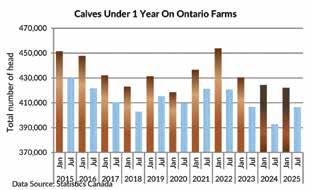
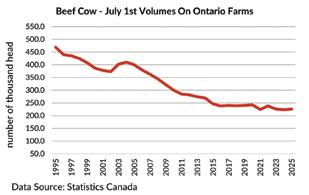
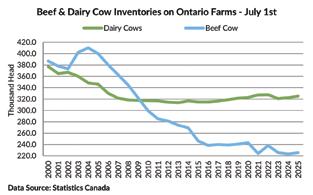
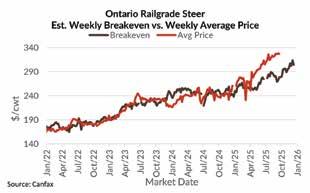
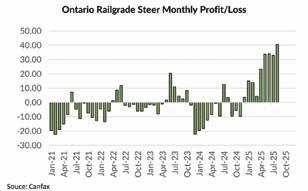
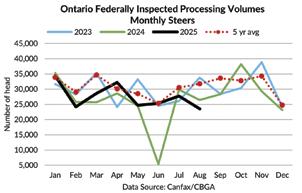


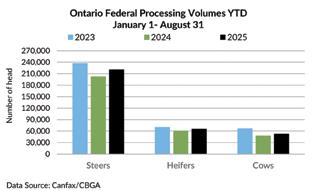
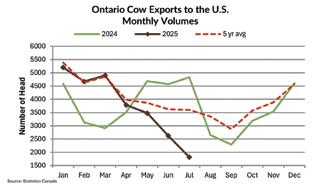
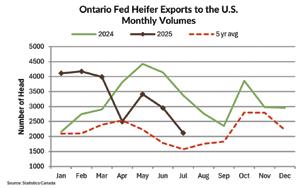
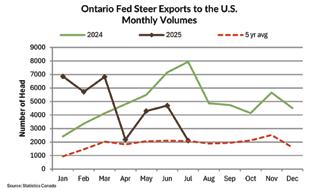
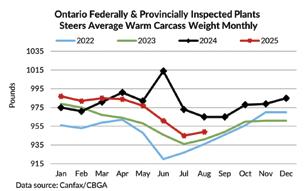
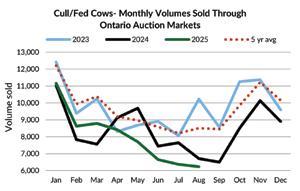

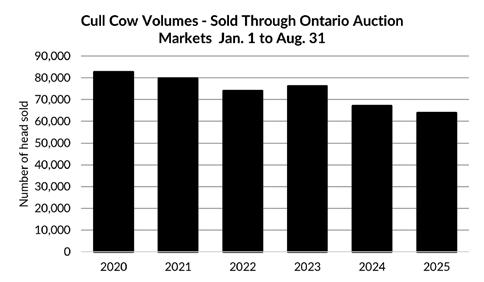
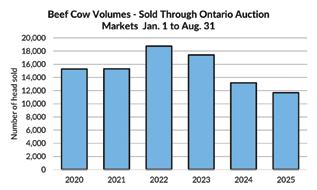
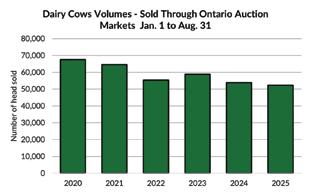
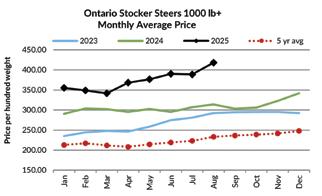
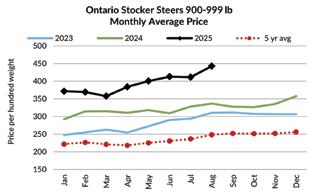
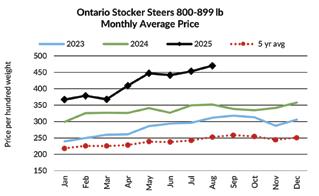
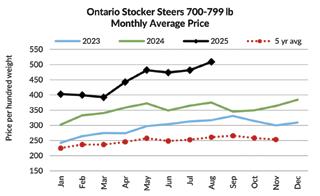
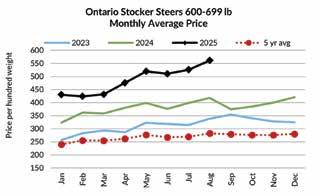

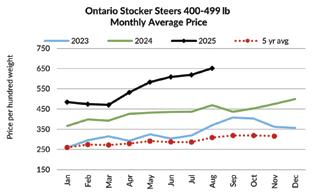

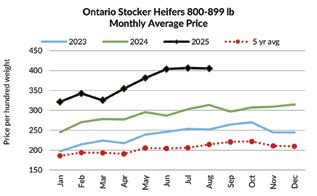
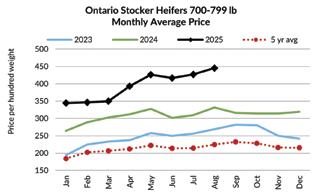



October 20 – Limousin Influence Sale, MapleHill Auctions, Walkerton
October 25 – 25th Annual Cream of the Crop Blonde d’Aquitaine Sale, Campbellford
October 26 – Leahy Select Sale, Douro
October 31 – Limousin Influence Sale, Cargill Auction Market, Campbellford
November 1 – Dudgeon Cattle Co and Guests Top Cut Bred Heifer Sale, Hanover
November 6 – The Biology of Condemnations Producer Workshop, Tavistock & District Memorial Hall
Royal Agricultural Winter Fair, Toronto, November 6 – Hereford Futurity Show
November 6 – Hereford Junior Show
November 8 – Eastern Hereford National November 8 – Building the Hereford Dream
November 7-16 – Royal Agricultural Winter Fair, Toronto, Ontario
November 8 – MapleHill Auction Bred Heifer Sale, Walkerton
November 14 – Ontario Stockyards Hereford Stocker Sale, Cookstown
November 15 – Ontario Shorthorn Association “Fall Classic Sale”, Maple Hill Auctions, Walkerton
November 23-25 – Advancing Women in Agri-Food Conference, Sheraton Fallsview, Niagara Falls
November 25-26 – OFA Annual General Meeting, Delta Hotel Toronto Airport & Conference Centre
December 6 – Carcass 101: Direct Beef Sales Workshop, University of Guelph
December 30 – Premier and Guests Falls View Production Sale, Toronto 2026
January 8-10 – Beef Industry Convention, Best Western Plus Lamplighter Inn, London. beefindustryconvention.com
February 17-19 – BFO Annual General Meeting, Delta Hotel Toronto Airport & Conference Centre
March 7 – Harprey Angus Farms Bull and Female Sale, Proton Station
March (date tba) – Source for Quality Bull Sale, Indian River

Daryl and Connie Clarke and Family 342 Chatham Street South, Blenheim, Ontario N0P 1A0 Herdsman and Marketing Manager Hugh M. Ross: 519-365-4026 hugh.clarkeffi@gmail.com


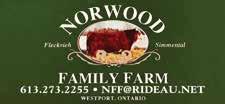


Special thanks to Robin Orr for sending in this photo of her daughter, Evelyn, who was excited to visit the mailbox to pick up the May edition of Ontario Beef. We appreciate all of our readers – young and old!
The Beef Farmers of Ontario (BFO) is committed to protecting the privacy and security of producers’ personal information in compliance with the Personal Information Protection and Electronic Documents Act (PIPEDA).
Subscribers to Ontario Beef magazine, the official publication of the Beef Farmers of Ontario, do so on a voluntary basis. By subscribing, subscribers are consenting to have their contact information used for the purposes of receiving the magazine and developing an BFO mailing list.
This mailing list will be used for the distribution of the BFO magazine.
The BFO will not sell, trade or otherwise share its Ontario Beef mailing list under any circumstances. A service may be provided whereby items are submitted to the BFO and mailed internally with the magazine but all materials must be approved by and acceptable to the BFO. In rare instances where external, non-commercial organizations, like the provincial or federal government, wish to use the Ontario Beef mailing list to distribute information, the government must provide their mailing materials in a finished format to BFO and/or its mailing house. BFO will then coordinate the mailing, at the requesting organization’s cost, thus maintaining confidentiality of the list. In cases where the BFO may commission a mailing, the company providing the service is required to sign a mandatory confidentiality agreement.
Subscribers to the Ontario Beef mailing list who wish to have their names removed, should call 519-824-0334 or email info@ontariobeef.com. Please allow 15 business days to allow us to update our records accordingly.
BFO’s complete privacy statement, covering areas of information including the electronic update system, Website, membership list and market information can be viewed on its Website at http://www.ontariobeef.com/privacy.asp

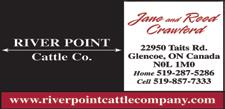











By Farm Credit Canada
Experts say Canadians, including farmers, need to have a healthy dose of skepticism when it comes to responding to requests for personal information in phone calls, emails and text messages.
“Check with the person you deal with most frequently at the institution,” says Jennifer Hogan, a Senior Cyber Security Specialist within the IT division of FCC. If the request is fraudulent, that alerts the organization to the activity, she says.
Many companies use multiple defensive measures to protect from email scams, including spam filters, antivirus and anti-malware scanners.
“This way, if one control fails, there are others to help detect and delay the attack,” Hogan says.
She says even with these measures, phishing emails can still get through, which is why individuals have a critical role to play in protecting information.
Hogan says there are several signs farmers can keep an eye and ear out for if they receive a call demanding funds.
“Is the caller talking quickly? Are they trying to get the person on the other end confused? Are they asking for personal information? Financial information?” she says.
The same goes for emails. Hogan says there are questions people should ask:
• Does the email make sense?
• Is the request within the character of the sender?
• Is this how you normally communicate with this sender?
• Do you feel uncomfortable or pressured by the email?
• Is this an unexpected email with a link or attachment?
• Is there bad grammar?
• Is there a request in the email asking for personal, financial or login credentials or information?
It’s always better to be cautious with requests for personal or confidential information.
If a request for personal information is received, the request should be checked out before any information is shared, experts say.
Shawna-Kay Thomas, former communications lead at Better Business Bureau agrees and says it’s always better to be cautious with requests for personal or confidential information.
“If you receive a call asking for that kind of information, you may want to hang up the phone and call back a legitimate number you have for that particular government agency and then follow-up with the request that is being made of you,” Thomas says.
Jeff Thomson is a senior RCMP intelligence officer currently managing the fraud prevention and intake unit at the Canadian AntiFraud Centre.
He says scams are tracked, and a list is available at the Canadian Anti-Fraud Centre, or by calling their toll-free line 1-888-495–8501, where they have several resources.
“We try to give you some key indicators as to what to watch for,” Thomson says of the website content.
Thomson says everyone gains when information about phone scams and how to avoid them is shared with family and friends.
“In doing so, you hear what is going on, on the ground,” Thomson says. “They may have heard something that you did not hear about, and in hearing your story, they’re able to prevent you from falling for those scandals.”

Thomson says that when a suspicious phone call is received, Canadians may want to consider using an initiative that started in the United Kingdom to combat schemes, called Take 5, Tell 2.
“Any types of funny calls you get - whether it is someone calling and threatening you or scaring you into performing something or asking for personal information - take a step back, don’t react, and then talk to other people.”
He says taking a step back and reflecting for five minutes or so, then speaking about the experience with two friends or family members, helps spread the word.
Suspicious phone calls, email or text messages should be reported to the local RCMP detachment.
Schemes requesting confidential personal or banking information are a regular occurrence for many Canadians, whether by phone call, email or text message. Experts offer several tips for gaining knowledge and verifying the authenticity of the requests, such as confirming the source of the call with the Canadian Anti-Fraud Centre or calling the organization directly. Experts also recommend sharing stories of fraudster requests with family and friends to raise awareness. OB
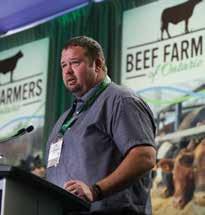
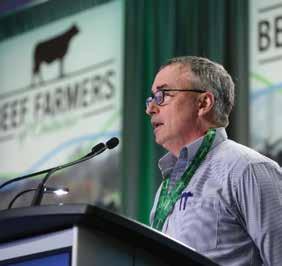
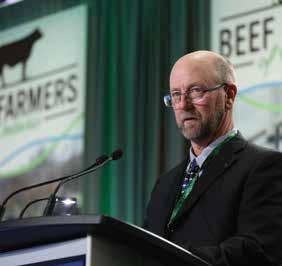

Beef Farmers of Ontario (BFO) is looking for passionate beef producers to step into leadership roles on the BFO Board of Directors, BFO Committees, and as representatives to the Canadian Cattle Association (CCA). As a producer-driven organization, BFO relies on strong leaders to identify priorities, shape policy, and advance solutions in areas like economic sustainability, animal health and welfare, food safety, the environment, and market development.
• Play a direct role in shaping the future of Ontario’s beef sector
• Network with industry leaders across Ontario and Canada
• Gain valuable leadership and governance experience
• Board and committee members are compensated for their time and expenses
BFO Board of Director Positions
• Cow-Calf Director (1)
• Background Director (1)
• Feedlot Director (2)
• Eastern Director (1)
Directors to CCA Positions
• CCA Representatives (2)
BFO Committee Positions
• Cow-Calf Members (3)
• Feedlot Members (3)
• Background Member on Feedlot Committee (1)
Ontario Beef Youth Alliance Positions
• Youth Member on BFO Cow-Calf Committee (1)
• Youth Member on BFO Feedlot Committee (1)
• Candidates must be elected as voting delegates at their local annual meeting and be members in good standing of BFO
• Nomination forms and a photo must be submitted to the BFO office by January 19, 2026
• Final deadline for nominations is February 3, 2026 (4:30 p.m.)
• Elections will take place at the BFO Annual General Meeting on February 18–19, 2026 in Toronto.
